Colombia is home to an incredibly diverse array of birds. With over 1,900 species present, the country is the second most biodiverse country in the world in terms of bird species.
To get a better understanding of the birds of Colombia, it is helpful to know about the different habitats and climates available for them to inhabit.
From the tropical lowlands to the high Andean plateaus, Colombia provides a variety of habitats for its birds. We will explore some of the most iconic birds of Colombia and their habitats.
1. Tanagers
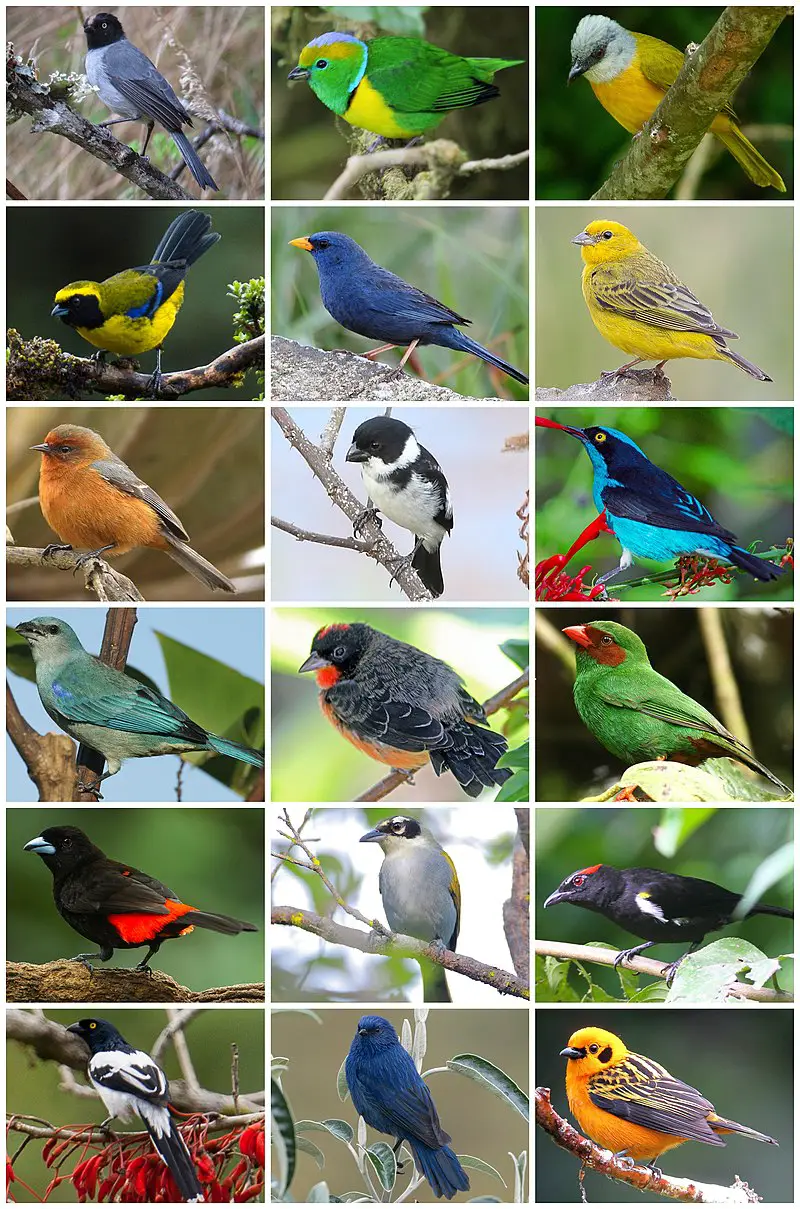
The Tanagers are a beautiful and diverse family of birds native to the Neotropical region. They boast an impressive array of colors, including blues, greens, yellows and reds.
The most common type is the fruit-eating tanager that can be found in tropical forests across Latin America. With nearly 240 species worldwide, they represent almost 4% of all avian species.
These vibrant birds have adapted well to their environment due to their strong bills used for cracking open hard fruits as well as sharp claws for gripping branches while feeding or perching.
As with many other bird families there is natural variation among populations making each one unique in its own way; something that makes them even more special.
Scientific classification:
| Kingdom | Animalia |
| Phylum | Chordata |
| Class | Aves |
| Order | Passeriformes |
| Superfamily | Emberizoidea |
| Family | Thraupidae Cabanis, 1847 |
2. Toucans
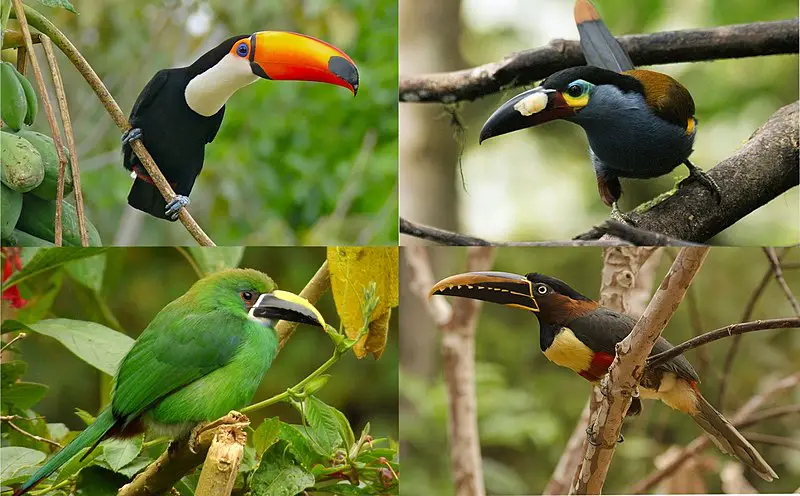
Toucans are members of the Ramphastidae family, which is closely related to American barbets. These birds have brightly-colored feathers and large beaks that come in a variety of colors.
They tend to live high up in trees, where they make their nests with two or four white eggs inside.
Toucans typically feed on fruits and sometimes small insects as well. Some species can even catch larger animals such as reptiles and amphibians for food.
Although toucans like to keep close together when living in groups, during breeding season they become more aggressive towards each other due to competition over resources like nesting sites or food sources.
Scientific classification:
| Kingdom | Animalia |
| Phylum | Chordata |
| Class | Aves |
| Order | Piciformes |
| Infraorder | Ramphastides |
| Family | Ramphastidae Vigors, 1825 |
3. Andean Cock-Of-The-Rock
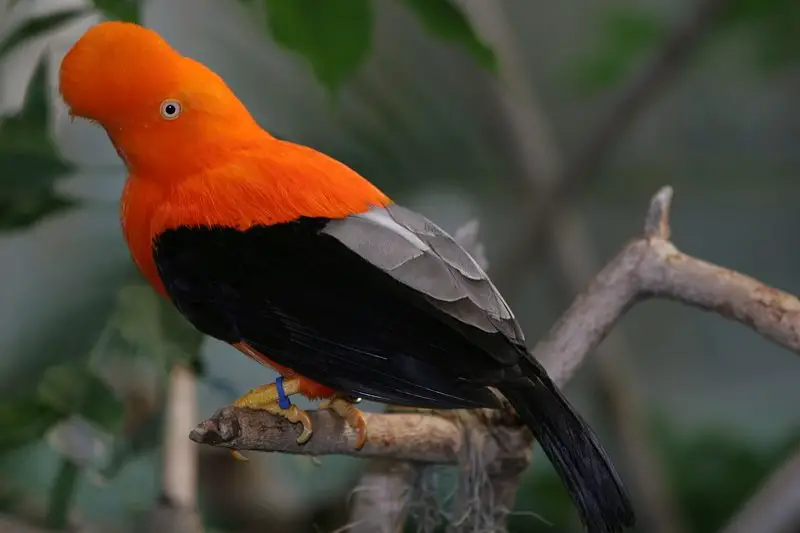
The Andean cock-of-the-rock is a large passerine bird belonging to the Cotinga family. It has four subspecies and can be found in the cloud forests of South America, notably Peru where it has been declared its national bird.
This species exhibits marked sexual dimorphism; males have an impressive orange crest that covers most of their head as well as a bright coral chest patch while females are mainly grey with dark wings and tail feathers.
Both sexes also feature black heads, yellow eyes, long bills and short legs.
Their diet consists mostly of fruits but they have also been known to eat small insects for protein.
They are monogamous birds who mate for life forming strong pair bonds that last several years until one partner dies or moves away from its territory.
Scientific classification:
| Kingdom | Animalia |
| Phylum | Chordata |
| Class | Aves |
| Order | Passeriformes |
| Family | Cotingidae |
| Genus | Rupicola |
| Species | R. peruvianus |
Also Featured In: Birds That Live in the Jungle, Rainforest Birds You Should Know
4. Andean Condor
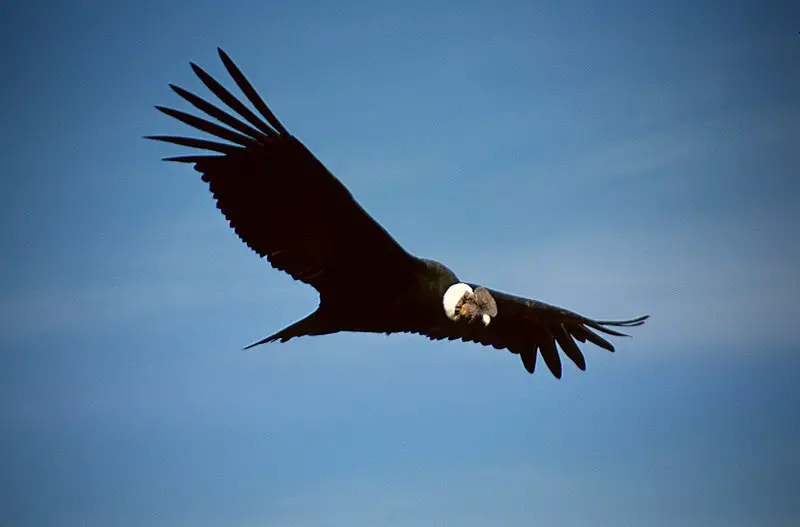
The Andean condor is a giant South American Cathartid vulture and the only member of its genus.
Found in the Andes mountains and along Pacific coasts, it is thought to be the largest flying bird on Earth by weight and wingspan with a maximum wingspan reaching up to 10 feet 10 inches (3.3 m) and weighing 33 lbs (15 kg).
It has mainly black plumage which helps keep it warm at high altitudes, while white patches adorn its head, neck, chest as well as underwing coverts.
Its powerful bill allows it to consume carrion efficiently while also being able to crack bones for nutrition when necessary.
The amazing flight capabilities of this majestic creature allow them soar through air thermals effortlessly; making them an impressive sight against clear blue skies.
Scientific classification:
| Kingdom | Animalia |
| Phylum | Chordata |
| Class | Aves |
| Order | Accipitriformes |
| Family | Cathartidae |
| Genus | Vultur Linnaeus, 1758 |
| Species | V. gryphus |
Also Featured In: Aviary Birds You Should Know, Flight Birds You Should Know
5. Multicoloured Tanager
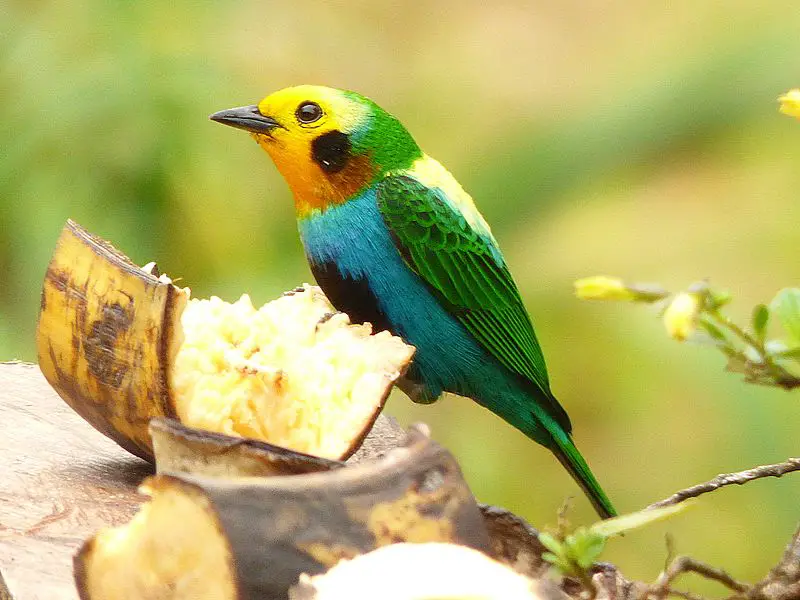
The Multicoloured Tanager is a stunningly vibrant bird endemic to the mountains of Colombia. It has distinctive yellow on its crown, face, mantle and throat; chestnut and black ear coverts; bright blue upperparts; brownish-olive rump with yellow edges; scarlet red underparts with white spots in front of the vent region.
The male’s bill is black while females have pale grey bills. This species can be found living in humid montane forests usually between 1,800 – 3100m above sea level.
Unfortunately due to deforestation it has been classified as vulnerable (VU) by IUCN since 2010. Conservation efforts are essential for this species if we want them around for future generations.
Scientific classification:
| Kingdom | Animalia |
| Phylum | Chordata |
| Class | Aves |
| Order | Passeriformes |
| Family | Thraupidae |
| Genus | Chlorochrysa |
| Species | C. nitidissima |
6. Antpitta
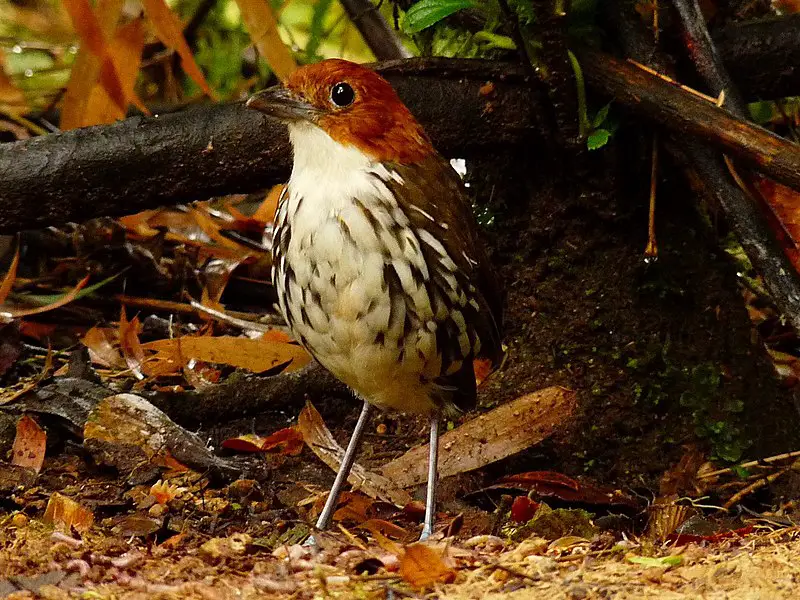
Antpittas are small passerine birds found in Central and South America. They measure 10-20 cm (4-8 inches) in length, making them some of the smallest members of their family Grallariidae.
These birds have a close relationship with both antbirds and gnateaters, which they were formerly placed alongside within the Formicariidae group.
Antpittas typically inhabit subtropical to tropical climates located near streams or other body water sources like rivers, ponds etc., where they forage for food on land but also take occasional dips into nearby bodies of water if needed.
In North America there is one species known as Ochthoeca frontalis which mainly inhabits Mexico’s western mountain ridge regions from Jalisco to Sonora states.
Scientific classification:
| Kingdom | Animalia |
| Phylum | Chordata |
| Class | Aves |
| Order | Passeriformes |
| Infraorder | Tyrannides |
| Parvorder | Furnariida |
| Family | Grallariidae P.L. Sclater and Salvin[1], 1873 |
7. Blue-Billed Curassow
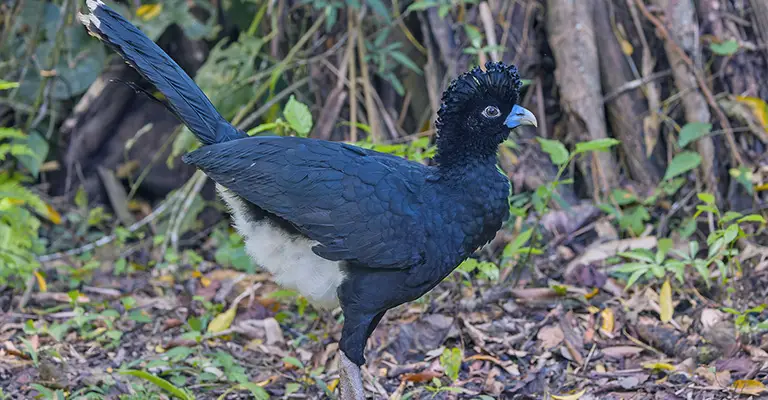
The Blue-billed Curassow is a species of bird that belongs to the family Cracidae, also known as chachalacas, guans and curassows.
Endemic to Colombia, this unique bird is monotypic; formerly it was considered a subspecies along with the Yellow-Knobbed Currasow which has since been classified separately.
The holotype for C. annulata has been identified as female Blue-Billed Currasow – another indication of its singularity.
With their striking deep blue bill and grey plumage they are certainly eye catching creatures that must be seen in their natural habitat to truly appreciate them in all their glory. They feed mainly on fruits but can include insects too when available.
Although threatened by deforestation these magnificent birds still roam freely through parts of Colombia’s forests giving us an insight into nature at its finest.
Scientific classification:
| Kingdom | Animalia |
| Phylum | Chordata |
| Class | Aves |
| Order | Galliformes |
| Family | Cracidae |
| Genus | Crax |
| Species | C. alberti |
Also Featured In: Birds You’ll Find in Zoo,
8. Santa Marta Parakeet
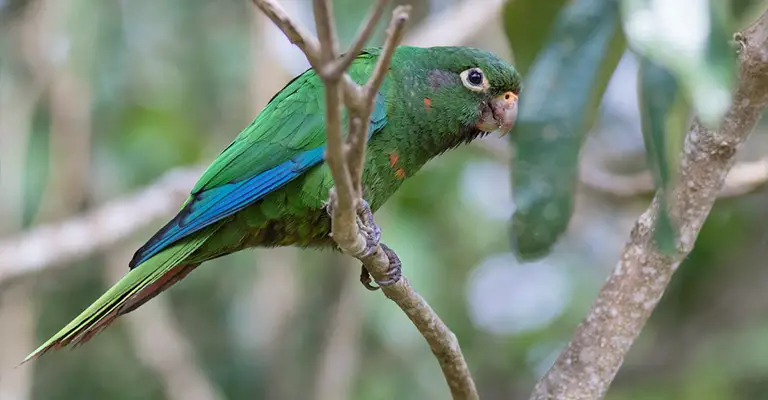
The Santa Marta parakeet is a species of parrot endemic to Colombia. This vibrant bird inhabits subtropical or tropical moist montane forests, however its population has sadly been declining due to habitat loss.
In 2006 researchers studied the eating habits of this species in order to learn more about its foraging ecology, with close observation revealing an omnivorous diet consisting mainly of fruits and insects.
The Santa Marta Parakeet is a small yet beautiful avian that should be admired and protected if we hope to ensure its survival into future generations.
Scientific classification:
| Kingdom | Animalia |
| Phylum | Chordata |
| Class | Aves |
| Order | Psittaciformes |
| Family | Psittacidae |
| Genus | Pyrrhura |
| Species | P. viridicata |
9. Keel-Billed Toucan
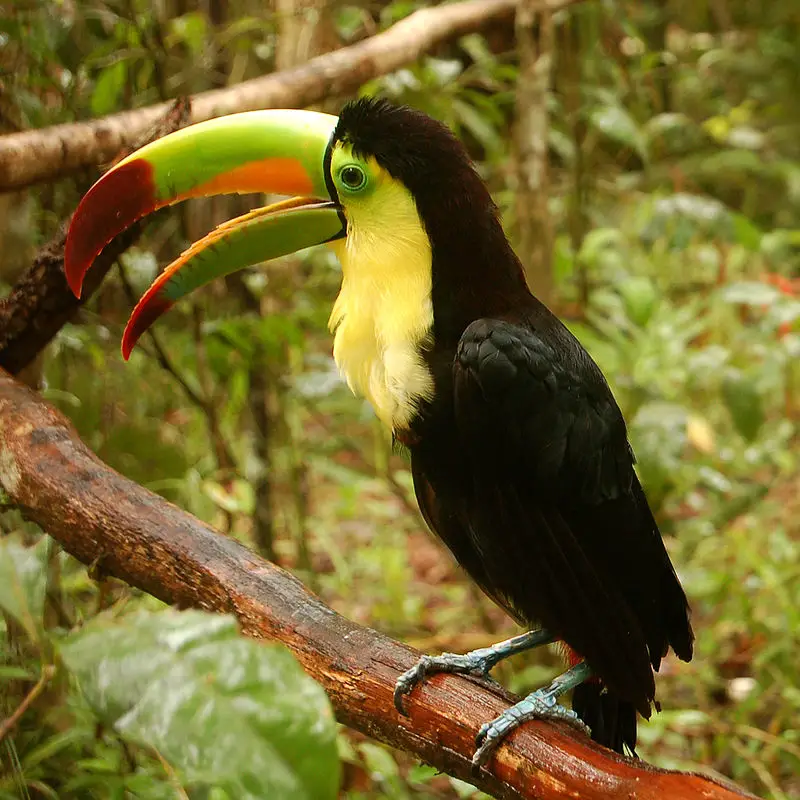
The Keel-billed Toucan is a vibrant Latin American bird from the toucan family and also serves as Belize’s national bird. They are found in tropical jungles stretching all the way from southern Mexico to Colombia.
They feed on fruits, seeds, insects, lizards and snakes – being omnivorous birds they eat pretty much anything.
These colourful creatures have an impressive beak with green upper parts of their bodies coupled with yellow lower halves.
The underside of their tail feathers are black while its tips remain white creating for quite a stunning display when flying or perched atop tree branches.
Scientific classification:
| Kingdom | Animalia |
| Phylum | Chordata |
| Class | Aves |
| Order | Piciformes |
| Family | Ramphastidae |
| Genus | Ramphastos |
| Species | R. sulfuratus |
Also Featured In: Most Common Birds in South America Birds, Common Latin America Birds
10. Gold-Ringed Tanager
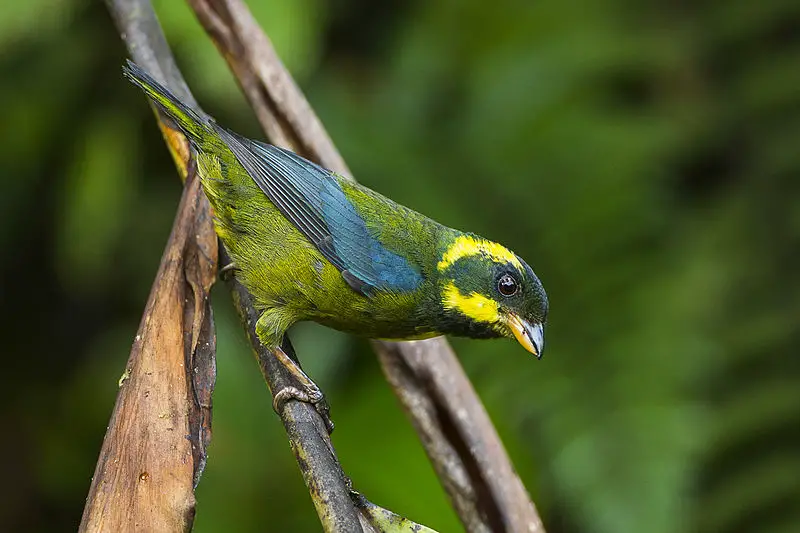
The Gold-ringed Tanager is a species of bird found only in Colombia. Its distinctively colored plumage, featuring a bright gold ring around its face, makes it stand out from other birds.
It lives mainly in high-altitude cloud forests on the slopes of the western Andes mountains and feeds mostly on fruit and insects.
Unfortunately for this beautiful creature, its population numbers are quite low due to deforestation and human disturbance which has caused much destruction to their native habitat over time.
As such, conservation efforts must be made to protect these precious creatures before they become endangered or worse still extinct.
Scientific classification:
| Kingdom | Animalia |
| Phylum | Chordata |
| Class | Aves |
| Order | Passeriformes |
| Family | Thraupidae |
| Genus | Bangsia |
| Species | B. aureocincta |
11. Ringed Kingfisher
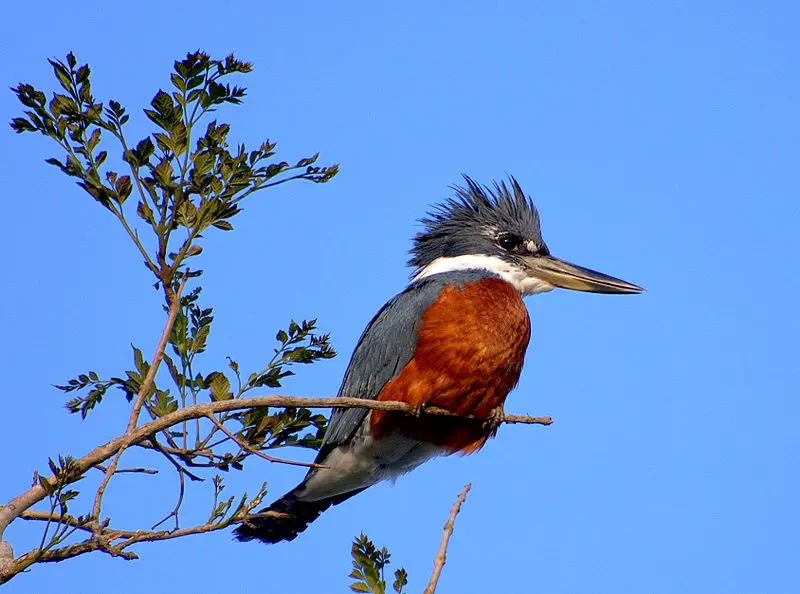
The Ringed Kingfisher is a large, vibrant bird that can be easily noticed by its loud call. It’s found in tropical regions from the lower Rio Grande Valley of southeastern Texas to Central America and even as far south as Tierra del Fuego.
This ground-dwelling species prefers to inhabit open areas near water bodies like streams, rivers and lakes which provide them with plenty of food such as fish, amphibians, crustaceans and insects.
In 1888 it was first identified by ornithologist Frank Chapman who noted its distinct ring pattern on the breast area.
The upperparts are dark blue while underneath they have white spots around their neck and belly region along with pale brown wings tipped in black stripes making this species quite unique among other kingfishers.
They may look intimidating but these birds actually play an important role for humans since they help control insect populations thus helping maintain a healthy balance within our ecosystems.
Scientific classification:
| Kingdom | Animalia |
| Phylum | Chordata |
| Class | Aves |
| Order | Coraciiformes |
| Family | Alcedinidae |
| Subfamily | Cerylinae |
| Genus | Megaceryle |
| Species | M. torquata |
Also Featured In: Birds You’ll Find in South Texas , Birds that Live in Guyana
12. Motmot
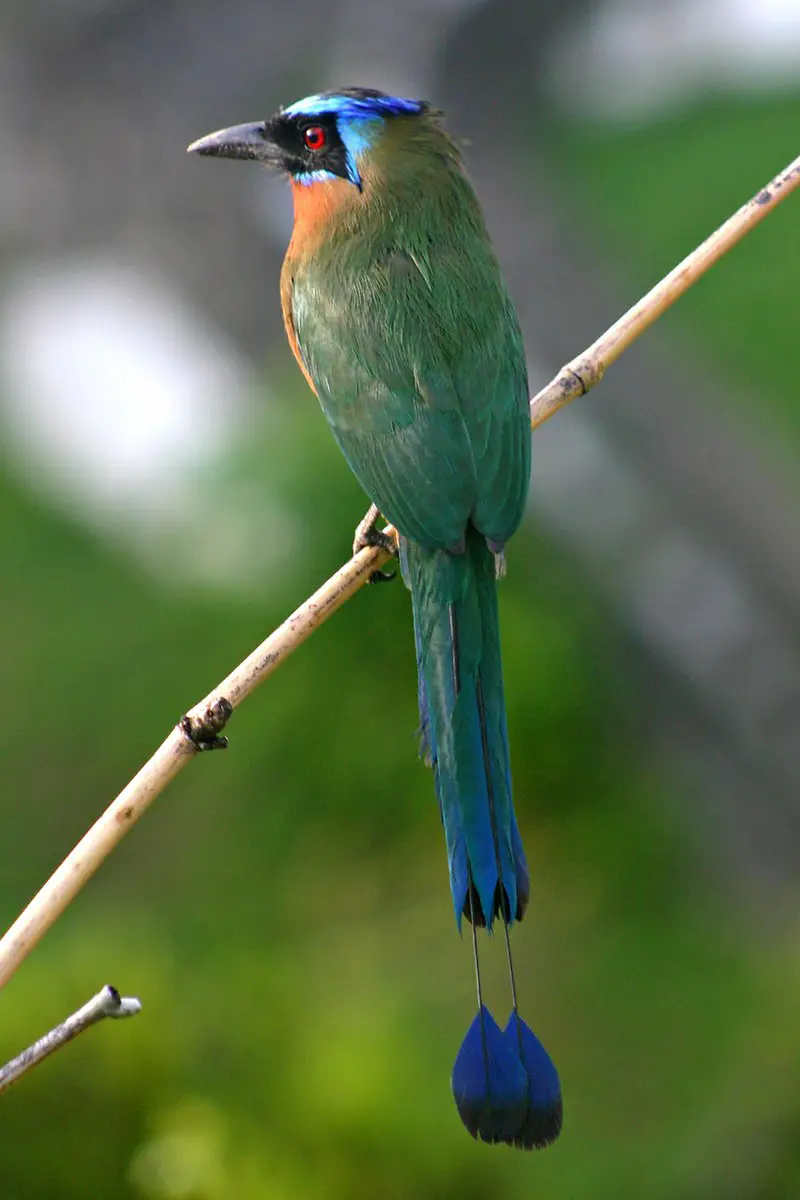
Motmots are a family of birds in the order Coraciiformes, known for their vibrant plumage and relatively heavy bills. They inhabit woodlands or forests across the Neotropics and can range in size from small to large.
The most distinctive feature of motmot species is their long tail feathers that some have adorned with unique patterns like eyespots.
Their diet consists mainly of insects but they will also eat smaller vertebrates such as lizards, frogs and fish.
Motmots are active during daylight hours where they can be seen perching on branches along forest edges or flitting through trees hunting prey.
These beautiful creatures have become an important part of many peoples’ lives throughout Latin America due to them being considered symbols of good luck by local cultures.
Scientific classification:
| Kingdom | Animalia |
| Phylum | Chordata |
| Class | Aves |
| Order | Coraciiformes |
| Family | Momotidae GR Gray, 1840 |
13. Colorful Puffleg
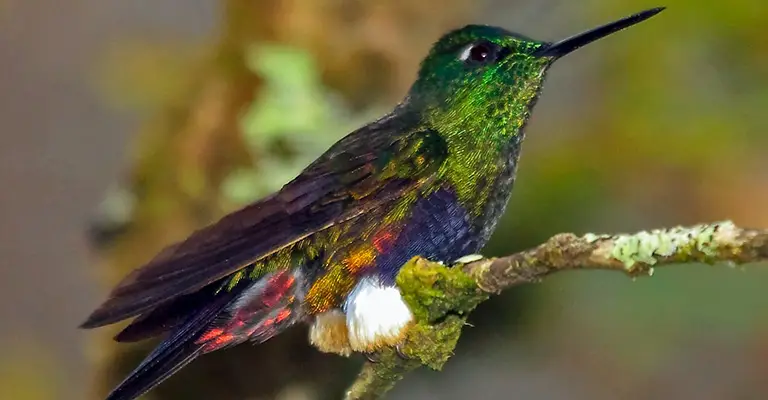
The Colorful puffleg is an endangered species of hummingbird that can only be found in Colombia. This unique bird belongs to the Heliantheini tribe and subfamily Lesbiinae, making it monotypic.
It has a close relationship with the Emerald-bellied Puffleg, which may even be considered part of a superspecies.
Some features include its iridescent plumage on its chest along with white feathers near its tail tip, as well as pink legs and toes adding to their vibrant appearance.
Conservation efforts have been made for this species due to overhunting by humans for commercial purposes such as pet trade or traditional medicine use, leading them closer towards extinction if not taken care of properly.
Scientific classification:
| Kingdom | Animalia |
| Phylum | Chordata |
| Class | Aves |
| Order | Apodiformes |
| Family | Trochilidae |
| Genus | Eriocnemis |
| Species | E. mirabilis |
14. Scarlet Macaw
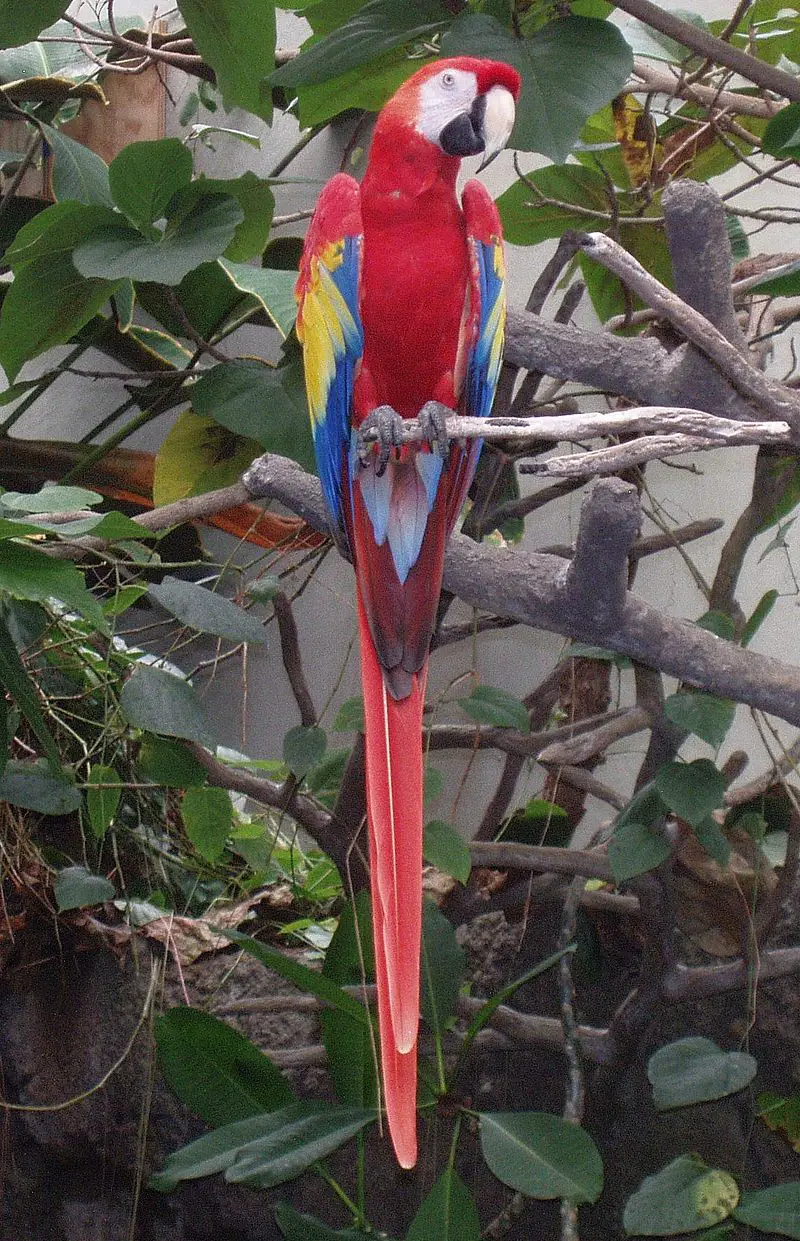
The Scarlet Macaw is a vibrant and beautiful bird found in Central and South America. Its striking red, yellow, and blue feathers make it stand out among other parrots.
It inhabits humid evergreen forests of the Neotropics from Mexico to Peru, Ecuador, Colombia, Bolivia Venezuela Brazil up to an altitude of 1000m (3300ft).
These birds have strong beaks which they use for breaking open hard nuts or seeds that would otherwise remain inaccessible.
They also form social bonds with their mates by grooming eachothers’ feathers and engaging in playful activities such as chasing one another around tree trunks.
Despite its vivid colors the Scarlet Macaw remains vulnerable due to habitat loss caused by deforestation so conservation efforts are essential if this amazing species is going to survive for future generations.
Scientific classification:
| Kingdom | Animalia |
| Phylum | Chordata |
| Class | Aves |
| Order | Psittaciformes |
| Family | Psittacidae |
| Genus | Ara |
| Species | A. macao |
15. Fuertes’s Parrot
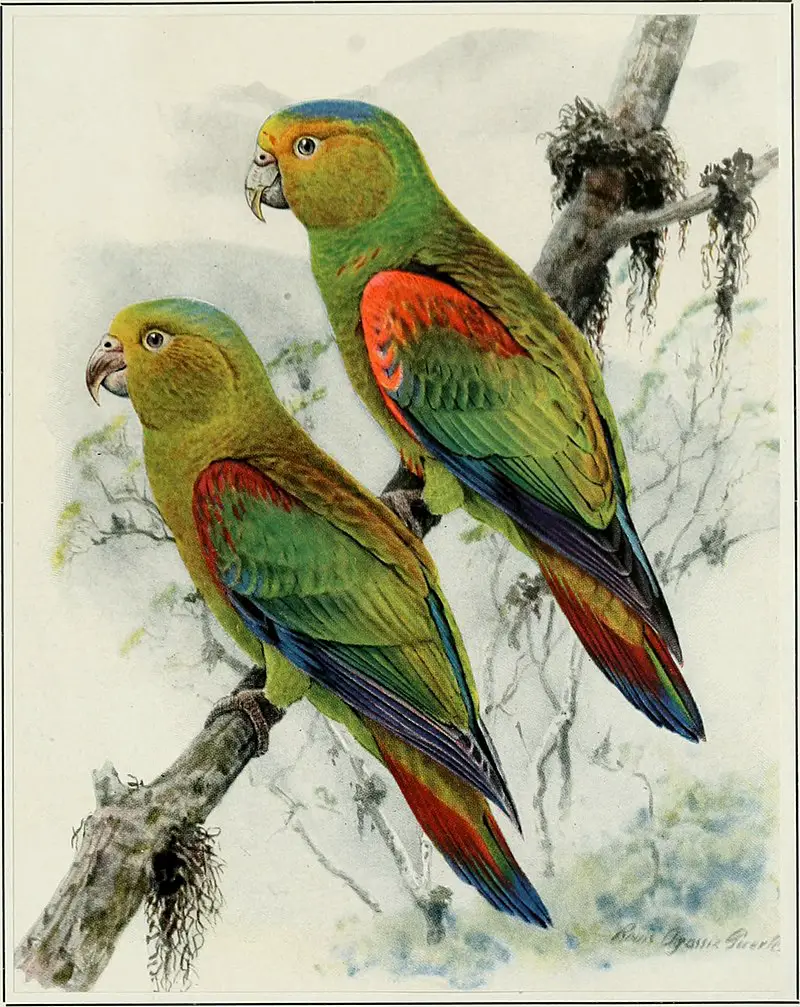
Fuertes’s parrot is a critically endangered species found on the west slope of the Central Andes in Colombia. It is approximately 24 cm long and has striking features such as green feathers, indigo-winged feathers, red shoulders and blue crown.
The bird is threatened by deforestation due to human activity which destroys its natural habitat.
Conservation efforts are being made to prevent their extinction but more needs to be done for this beautiful creature including protecting their habitats from destruction through sustainable practices such as reforestation initiatives and wildlife protection laws.
Hopefully these actions will ensure that Fuertes’s parrot can continue living in its native environment for years to come.
Scientific classification:
| Kingdom | Animalia |
| Phylum | Chordata |
| Class | Aves |
| Order | Psittaciformes |
| Family | Psittacidae |
| Genus | Hapalopsittaca |
| Species | H. fuertesi |
16. Wattled Jacana
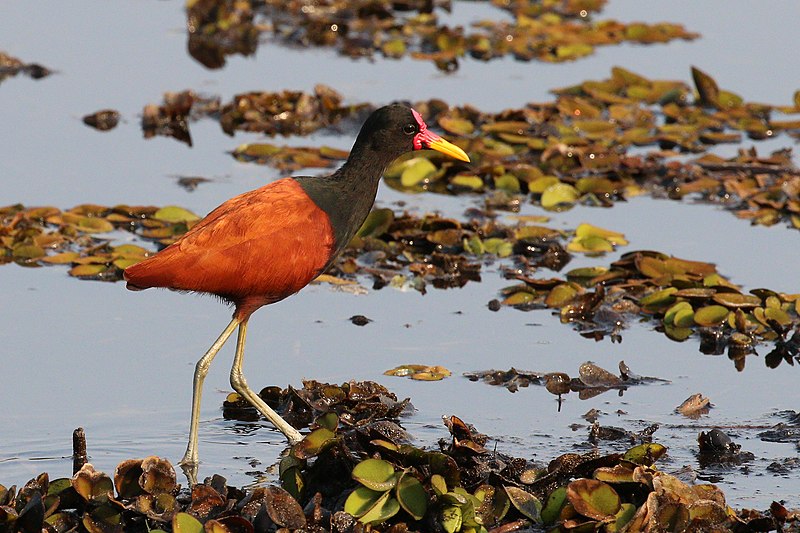
The Wattled Jacana is a stunning bird from central and south America. It has long legs, a black head with yellow wattles at each side, and striking chestnut brown wings.
This wader builds its nest on the surface of ponds or lakes using floating vegetation such as lily pads to anchor it in place – usually with four eggs that are darkly marked.
The male takes primary responsibility for incubation of these eggs between his wings, while the female will take care of her chicks once they hatch out.
These birds feed mainly on aquatic insects but also small fish and amphibians if available.
Overall this species is an interesting and attractive addition to any wetland habitat.
Scientific classification:
| Kingdom | Animalia |
| Phylum | Chordata |
| Class | Aves |
| Order | Charadriiformes |
| Family | Jacanidae |
| Genus | Jacana |
| Species | J. jacana |
17. Crested Ant Tanager
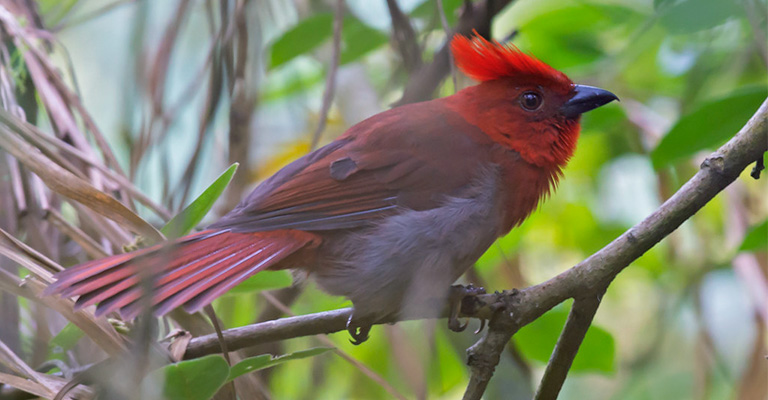
The Crested Ant Tanager is a beautiful bird which is endemic to Colombia and belongs to the Cardinalidae family. It has a distinctive crest on its head, making it easily recognizable in their natural habitat.
This species of tanager was originally placed under Thraupidae but recent DNA analysis revealed that they were more closely related to cardinals instead so they were moved accordingly.
They are monotypic meaning there are no other subspecies within this particular species, hence why conservation efforts for them must be looked into deeply as being an only one makes them particularly vulnerable if any changes occur in their environment or if anything else threatens their population numbers.
Scientific classification:
| Kingdom | Animalia |
| Phylum | Chordata |
| Class | Aves |
| Order | Passeriformes |
| Family | Cardinalidae |
| Genus | Habia |
| Species | H. cristata |
18. Tropical Mockingbird
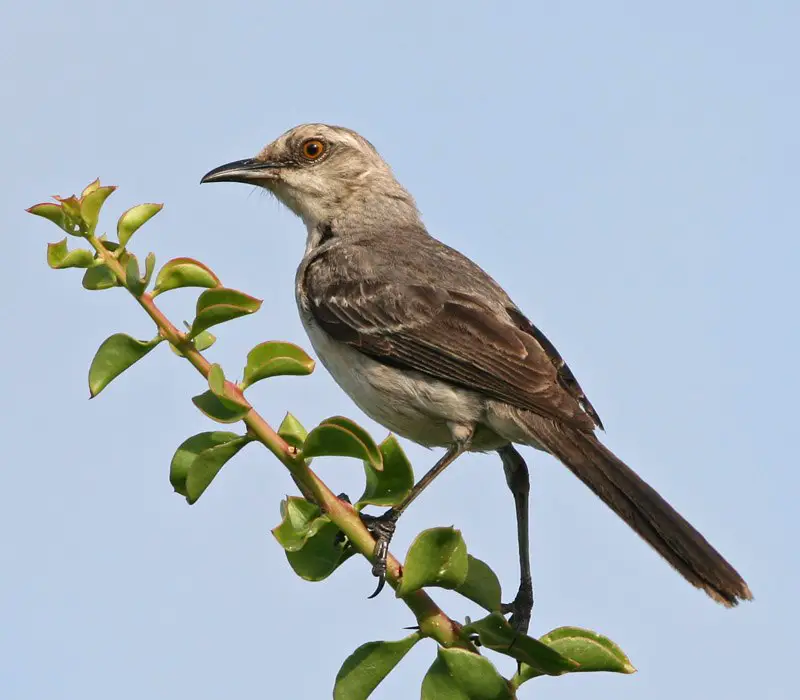
The Tropical mockingbird is a species of bird found throughout Central America and the Caribbean. It has been classified as a resident breeding bird, with its range stretching from southern Mexico to northern and eastern South America.
This species is closely related to the Northern Mockingbird, forming what is known as a superspecies between them both.
The Tropical mockingbird can be recognized by its grey-brown coloration on top, blending into white underparts which are highlighted by black spots along their throat and wings.
They have long legs for perching in trees or shrubs while searching for prey such as insects before singing out melodic songs during territorial disputes with other birds in the area.
Sadly, one subspecies -the San Cristobal Mockingbird – has been listed as critically endangered due to habitat destruction caused by human activities including logging within their natural environment.Scientific classification:
| Kingdom | Animalia |
| Phylum | Chordata |
| Class | Aves |
| Order | Passeriformes |
| Family | Mimidae |
| Genus | Mimus |
| Species | M. gilvus |
Also Featured In: Caribbean Birds, Most Common Birds You’ll Find in Quintana Roo
19. Sooty-Capped Puffbird
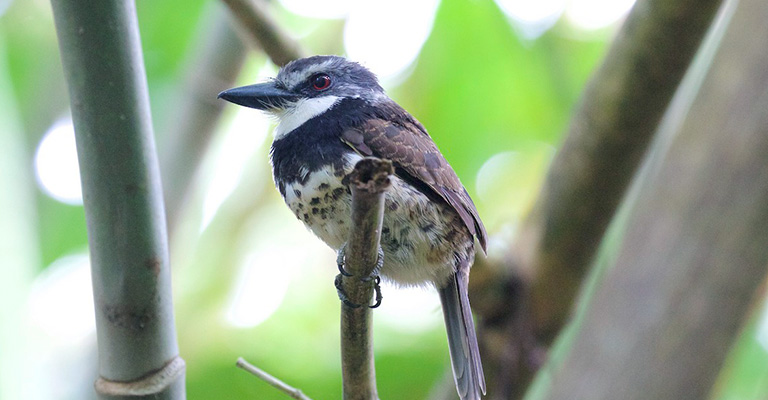
The Sooty-capped puffbird is a species of bird belonging to the family Bucconidae. It can be found only in Colombia and was initially placed in genus Nystactes during the first half of the 20th century.
However, it was later classified as part of Bucco after more research had been conducted on its characteristics and behavior.
The International Ornithological Committee (IOC) and the Clements taxonomy have both accepted this classification which makes it one of seven members that belong to this family group.
This medium sized bird has an overall grayish coloration with sooty upperparts, white underparts, black head feathers forming crest-like tufts around its face creating quite a distinctive look against other birds in similar habitats such as dense foliage or trees where they usually inhabit from sea level up to higher altitude areas within forests .
Scientific classification:
| Kingdom | Animalia |
| Phylum | Chordata |
| Class | Aves |
| Order | Piciformes |
| Family | Bucconidae |
| Genus | Bucco |
| Species | B. noanamae |
20. Red-Crowned Woodpecker
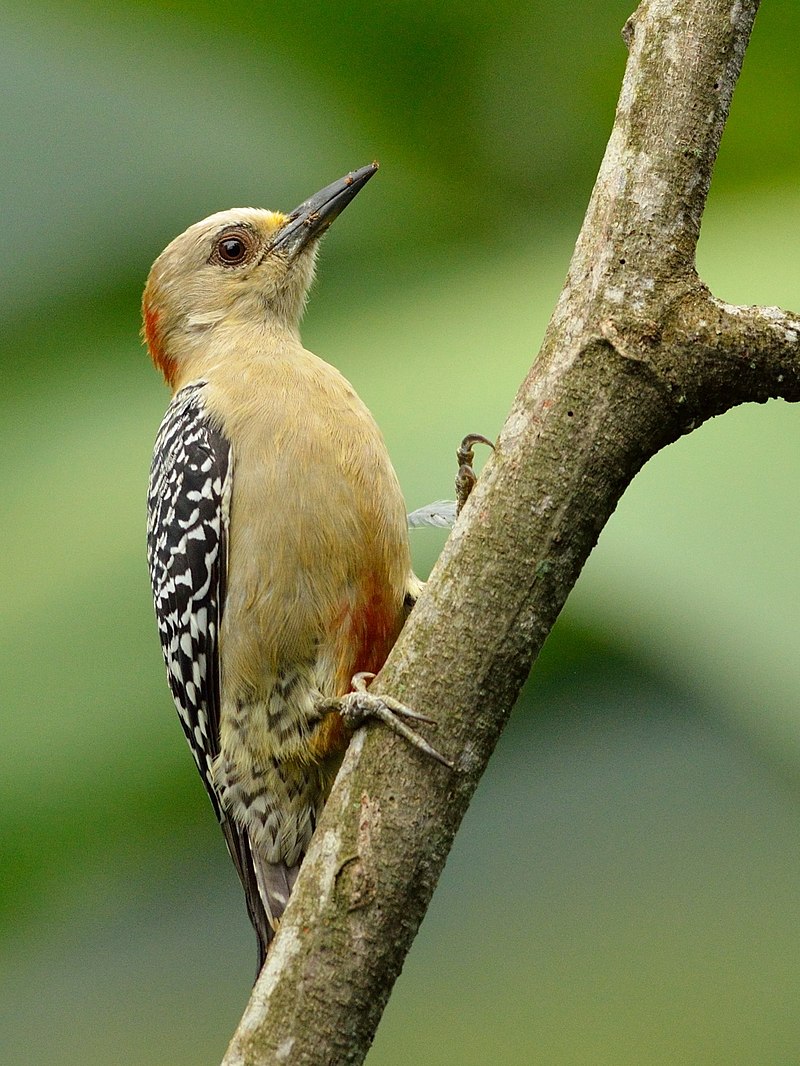
The red-crowned woodpecker is a striking bird, native to areas of Central and South America.
It measures 17 cm in length and weighs 55 g, with black and white zebra-barred wings and back contrasting against its pale buff brown underparts.
The most eye catching feature though is the male’s bright red crown, which has earned it its name.
This species prefers open forests or woodland edges where they can find their favourite food – insects hidden in dead tree trunks.
When not hunting for food these birds will often be seen drumming on trees as part of courtship rituals between males or as territorial displays towards other animals invading their territory.
Scientific classification:
| Kingdom | Animalia |
| Phylum | Chordata |
| Class | Aves |
| Order | Piciformes |
| Family | Picidae |
| Genus | Melanerpes |
| Species | M. rubricapillus |
Also Featured In: Common Margarita Island Birds,
21. Blue-Gray Tanager
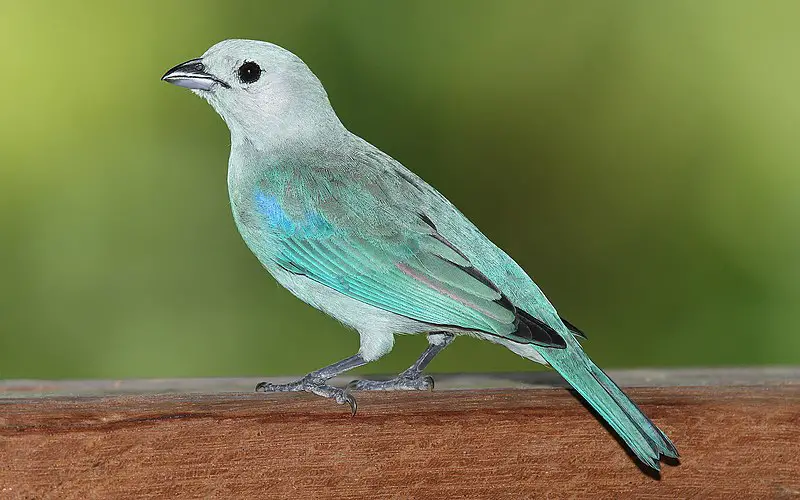
The blue-gray tanager is a medium-sized songbird native to South America, ranging from Mexico all the way down to northern Brazil and Bolivia.
It has been introduced in Lima, Peru as well as Trinidad and Tobago where it is called “blue jean”.
This species was first described by French zoologist Mathurin Jacques Brisson in 1760. The bird’s plumage features hues of gray, blue, yellow and green creating an attractive contrast against its white belly.
Its diet consists mainly of insects like beetles but also fruits such as figs are known to be part of their daily nutrition.
Blue-gray tanagers usually inhabit humid forests near running watercourses making them relatively easy to spot while they search for food on tree branches or foliage cover around streams during the day time.
Scientific classification:
| Kingdom | Animalia |
| Phylum | Chordata |
| Class | Aves |
| Order | Passeriformes |
| Family | Thraupidae |
| Genus | Thraupis |
| Species | T. episcopus |
22. Smooth-Billed Ani
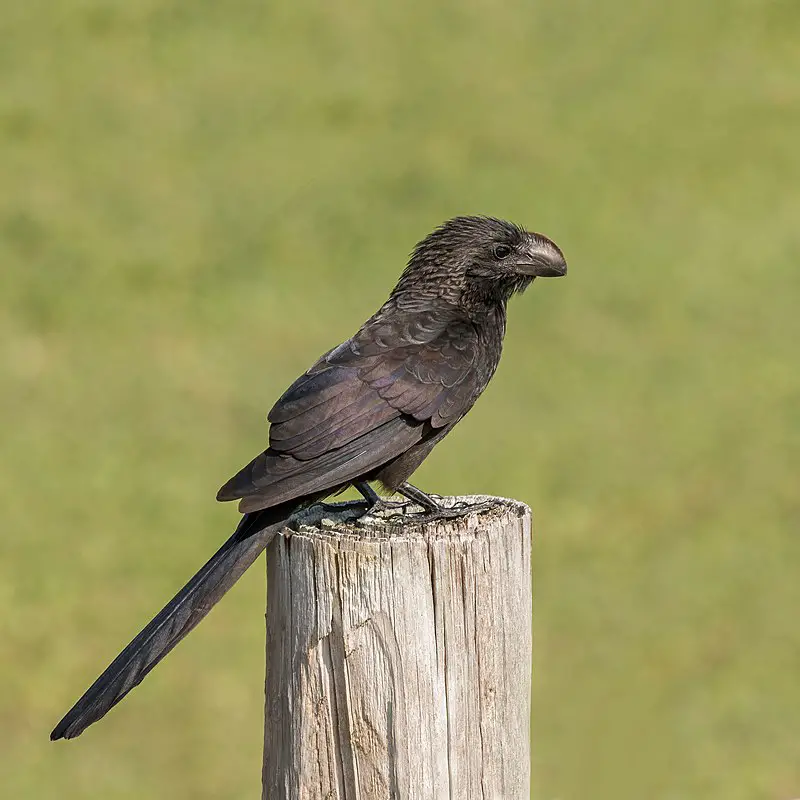
The Smooth-billed Ani is a species of bird in the cuckoo family, native to regions spanning from southern Florida and the Caribbean down through Central America, South America, and parts of Argentina.
They have even been introduced to Galapagos around 1960s where they may be impacting local wildlife due to their aggressive nature.
As its name suggests, these birds have smooth bills which are adapted for feeding on hard fruits or other items such as insects and lizards that it finds while scavenging around trees or ground level vegetation.
They usually form small flocks when out searching for food with males being slightly larger than females.
Overall this adaptable species is found in many habitats across its broad range but does best at low elevation open areas near water sources like marshes or swamps making them easier targets for human disturbance as well.
Scientific classification:
| Kingdom | Animalia |
| Phylum | Chordata |
| Class | Aves |
| Order | Cuculiformes |
| Family | Cuculidae |
| Genus | Crotophaga |
| Species | C. ani |
Also Featured In: Birds that You’ll Find in Puerto Rico, British Virgin Islands Birds You Need to See
23. Ruddy Ground Dove
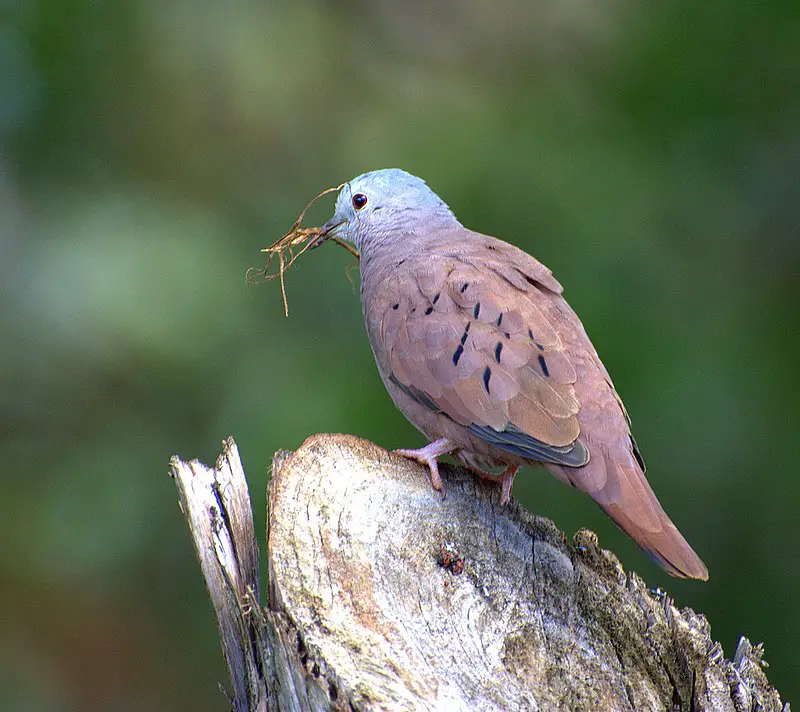
The Ruddy Ground Dove is a small New World tropical bird, found across Mexico and South America as far south as Argentina. It is also seen in the southwestern United States during winter months.
This ground dove typically lives in scrub or other open habitats such as savannas and grasslands, where it feeds on seeds from plants like cactus fruits.
Its plumage ranges from grey to reddish-brown with a light tan breast and black markings throughout its wings and tail feathers.
The male has more distinguishable colouration than the female but both sexes have bright red eyes which give this species its name – ‘ruddy’.
They are often observed perching low to the ground near food sources or nesting sites while also being quite vocal when flying between locations making them easier to spot.
Scientific classification:
| Kingdom | Animalia |
| Phylum | Chordata |
| Class | Aves |
| Order | Columbiformes |
| Family | Columbidae |
| Genus | Columbina |
| Species | C. talpacoti |
24. Eared Dove
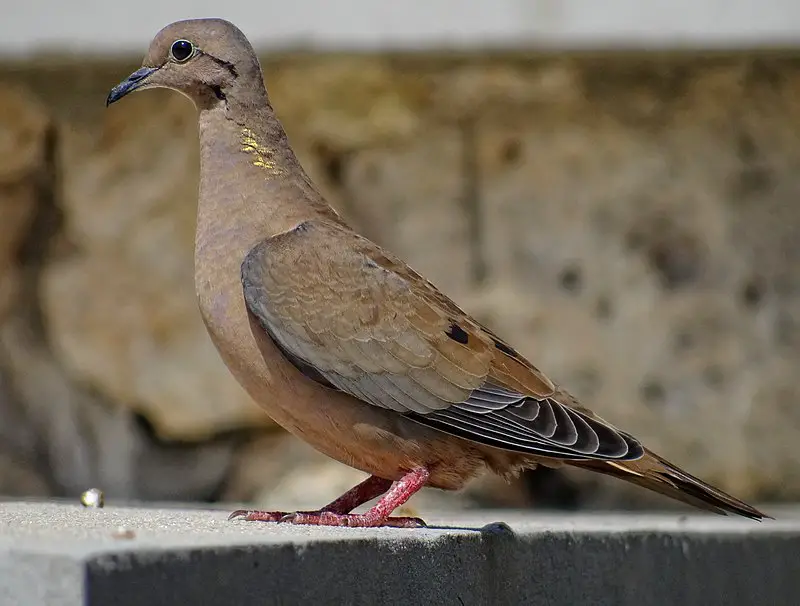
The Eared Dove is a beautiful bird that can be found throughout South America, ranging from Colombia to Argentina and Chile. It has also been spotted in Trinidad and Tobago recently.
This species tends to be partially migratory depending on food supplies available in the area, making it an important part of the local environment.
Its plumage tends to vary by region with some individuals having brighter colors than others where they are found near forested areas or along coasts.
The most recognizable feature of this dove is its ear tufts which gives it its common name – Eared Dove.
These doves have a soft cooing sound as their call which makes them truly unique among other birds in their range.
Scientific classification:
| Kingdom | Animalia |
| Phylum | Chordata |
| Class | Aves |
| Order | Columbiformes |
| Family | Columbidae |
| Genus | Zenaida |
| Species | Z. auriculata |
Also Featured In: Birds Live In San José Island,
25. Black-And-Gold Tanager
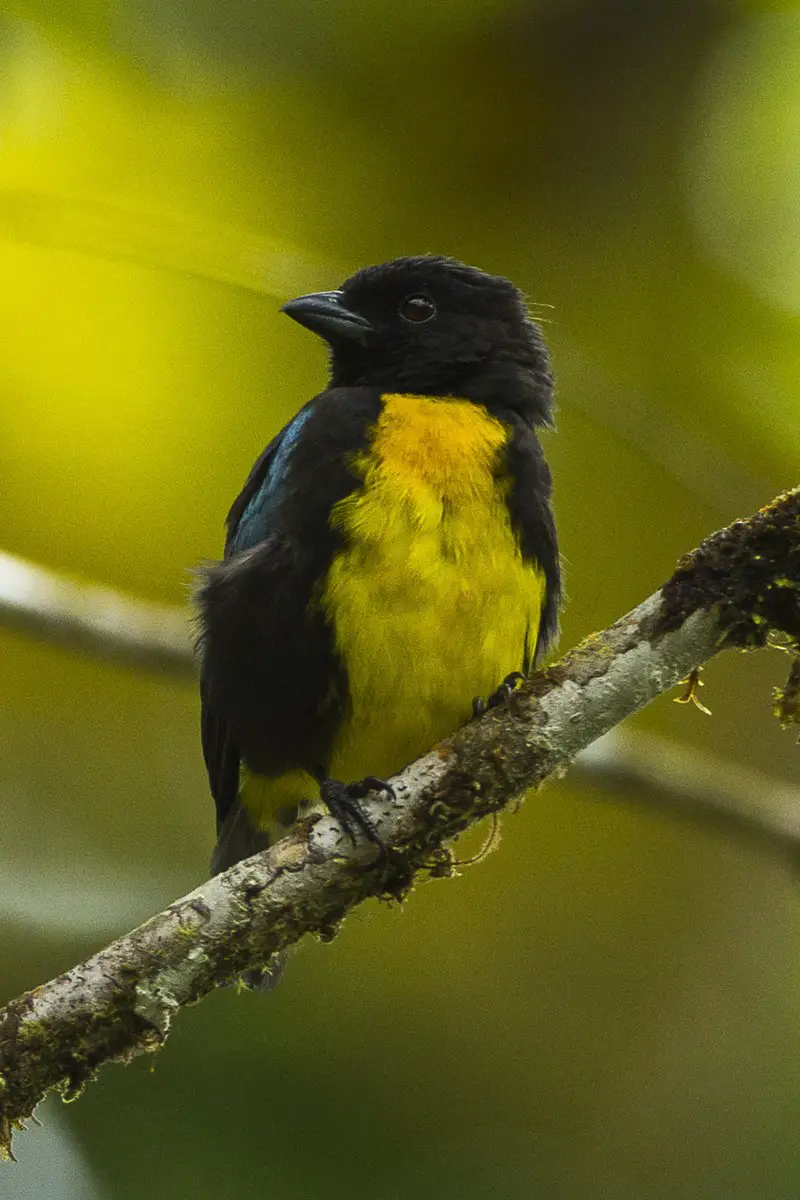
The Black-and-gold Tanager is a beautiful species of bird found only in Colombia. It has black and gold feathers which give it its distinctive name, and loves to live in moist montane forests.
Unfortunately its natural habitat is under threat due to deforestation, making the future of this unique creature uncertain. Conservation efforts are needed so that we can ensure these birds continue living for generations to come – protecting their habitats from human interference could go a long way towards helping them survive.
For now however, they remain an endangered species with dwindling numbers across the country. We must act fast if we want these majestic creatures around for years to come.
Scientific classification:
| Kingdom | Animalia |
| Phylum | Chordata |
| Class | Aves |
| Order | Passeriformes |
| Family | Thraupidae |
| Genus | Bangsia |
| Species | B. melanochlamys |
26. Chestnut-Bellied Hummingbird
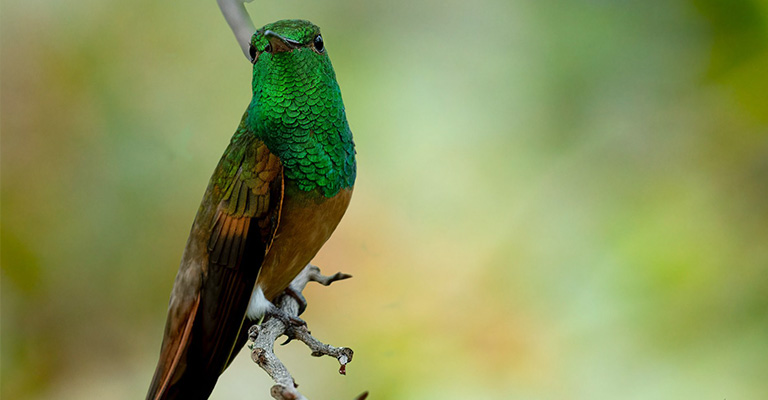
The Chestnut-bellied Hummingbird is a Near Threatened species of hummingbird, endemic to Colombia.
It was previously placed in the genus Amazilia but a molecular phylogenetic study published in 2014 found that this genus was polyphyletic and so the Chestnut-bellied Hummingbird now belongs to its own tribe Trochilini within subfamily Trochilinae.
This small bird has iridescent green upperparts, with an olive wash on its crown and nape while underparts are pale buffy white, becoming chestnut brown on their flanks and undertail coverts.
The male can be distinguished by having an emerald throat patch bordered below by a black gorget which females lack.
Its diet consists mainly of nectar from flowers but also includes insects for added protein intake as well as sap taken from holes made by sapsuckers like woodpeckers or barbets.
Scientific classification:
| Kingdom | Animalia |
| Phylum | Chordata |
| Class | Aves |
| Order | Apodiformes |
| Family | Trochilidae |
| Genus | Saucerottia |
| Species | S. castaneiventris |
27. Thick-Billed Euphonia
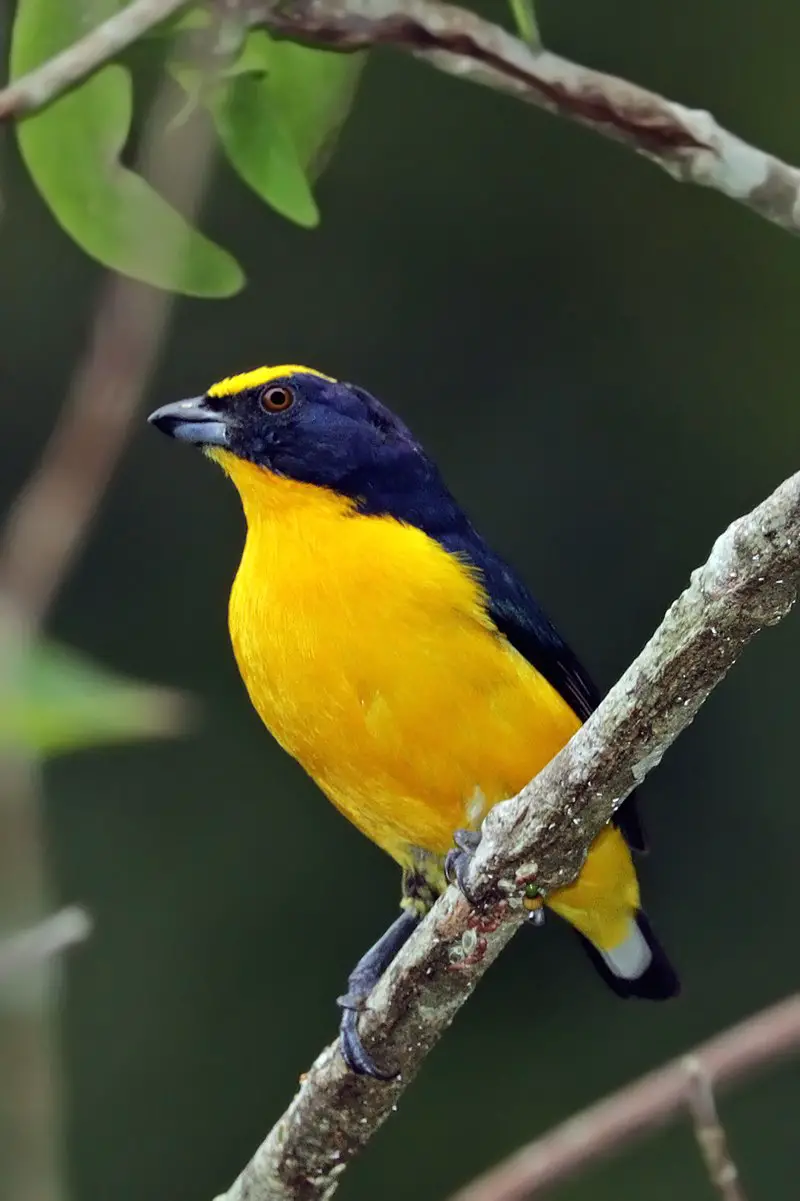
The Thick-billed Euphonia is a small bird native to Central and South America. It measures 10 cm in length, with bright yellow underparts that contrast sharply with its dark blue-black upper parts and yellow crown patch on the head.
The male of this species has an additional terminal white patch at the undertail. This attractive bird typically inhabits forest edges, woodland areas and savannas where it feeds on insects, fruit and nectar from flowers.
Its call is described as a sharp chirping sound made up of several notes each ending abruptly.
As their numbers are decreasing due to deforestation or capture for trade purposes they have become vulnerable across some parts of their range; conservation efforts must be put into place if we wish to keep them around for many more years.
Scientific classification:
| Kingdom | Animalia |
| Phylum | Chordata |
| Class | Aves |
| Order | Passeriformes |
| Family | Fringillidae |
| Subfamily | Euphoniinae |
| Genus | Euphonia |
| Species | E. laniirostris |
28. Brown-Banded Antpitta
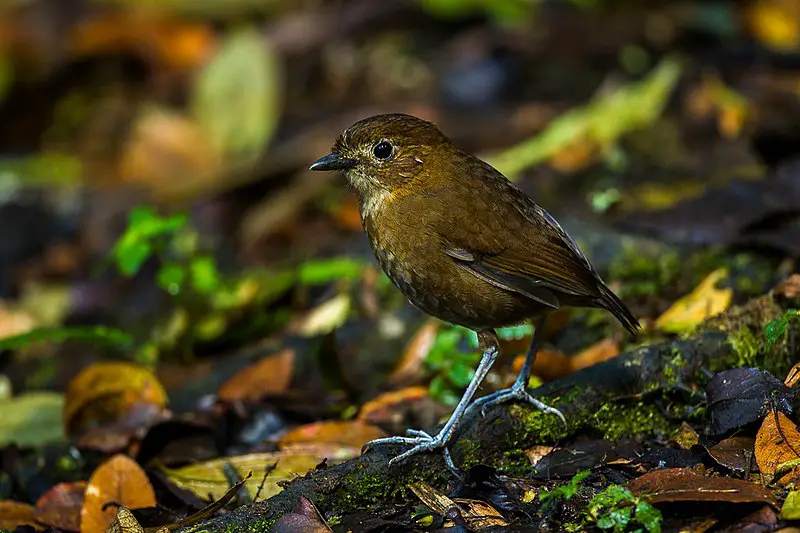
The brown-banded antpitta is a species of bird found exclusively in Colombia. It has distinctive dark brown feathers with white stripes on its chest and wings, giving it the common name “brown-banded”.
These birds live primarily in subtropical or tropical montane forests but can also be found inhabiting plantations near their natural habitat.
Unfortunately, they are threatened by human activities such as deforestation which destroy their homes and food sources.
Conservation efforts must be made to protect this species from extinction due to its limited range and declining population numbers over recent years.
Scientific classification:
| Kingdom | Animalia |
| Phylum | Chordata |
| Class | Aves |
| Order | Passeriformes |
| Family | Grallariidae |
| Genus | Grallaria |
| Species | G. milleri |
29. Red-Billed Emerald
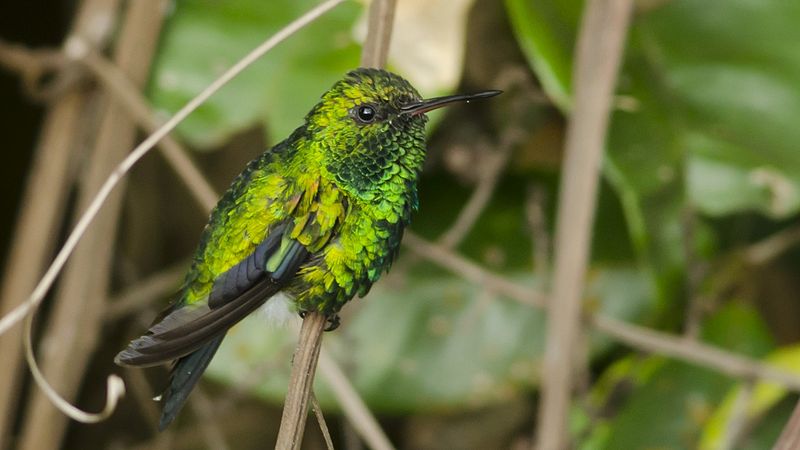
The Red-billed Emerald is a species of hummingbird found in Colombia and Venezuela. It was once classified as a subspecies of the Blue-tailed Emerald, but since the early 2000s has been recognised as its own distinct species.
This vibrant bird has an emerald green body with dark wings, tail feathers tipped in black and white markings on its head. Its red bill sets it apart from other members of this family; hence the name.
The Red-billed Emerald feeds mainly on nectar which it obtains using their long curved bills to reach deep into flowers for sustenance.
These birds can be seen flitting between gardens or hovering around trees looking for food sources while emitting loud chirping noises that sound like they’re saying “tsit tsit”.
Scientific classification:
| Kingdom | Animalia |
| Phylum | Chordata |
| Class | Aves |
| Order | Apodiformes |
| Family | Trochilidae |
| Genus | Chlorostilbon |
| Species | C. gibsoni |
30. Chestnut Wood Quail
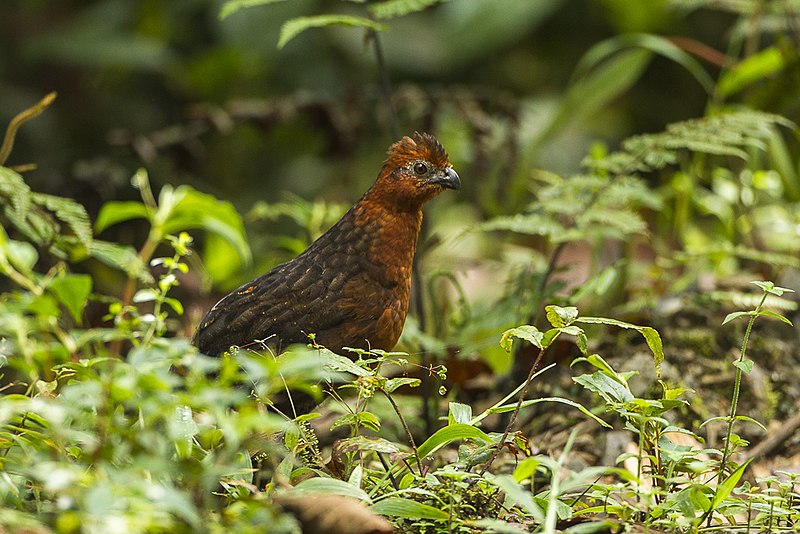
The Chestnut Wood Quail, found exclusively in Colombia, is a beautiful bird species belonging to the family Odontophoridae. It has reddish-brown upperparts and underparts with black barring on its wings and tail feathers.
Its head is chestnut red with a white stripe over its eye which gives it an attractive appearance. This quail prefers dense forest habitats but can also be seen at edges of cultivated areas where they feed mainly on seeds and insects.
The population of this species is declining due to destruction of their habitat by deforestation for agricultural purposes leading them towards extinction if not conserved immediately.
Scientific classification:
| Kingdom | Animalia |
| Phylum | Chordata |
| Class | Aves |
| Order | Galliformes |
| Family | Odontophoridae |
| Genus | Odontophorus |
| Species | O. hyperythrus |
31. New World Barbet
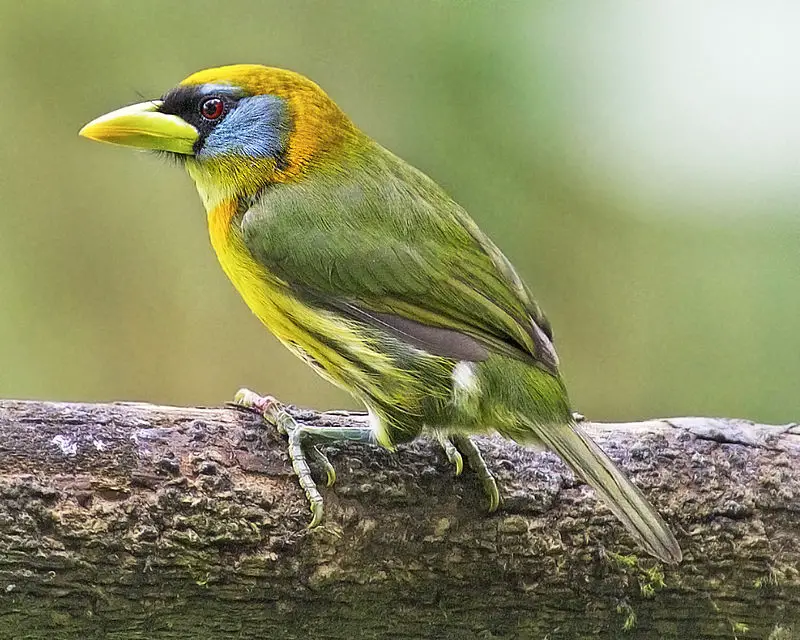
New World barbets are beautiful birds belonging to the family Capitonidae and order Piciformes, found in humid forests of Central America and South America.
They have a plump body with short necks and large heads covered by bristles around their heavy bills.
These brightly coloured creatures inhabit tropical forests, making them an exciting sight for bird watchers.
The diet of these birds mainly consists of fruits from trees such as figs or other soft-bodied insects like caterpillars which they feed on using their strong beaks.
Barbets are usually seen alone but can also form small flocks when searching for food sources together or during migration periods between different locations within the same region.
Although not much is known about New World barbet breeding habits, it has been observed that they nest in cavities formed inside tree trunks or branches close to where food sources are abundant throughout the year.
This helps ensure successful offspring growth even during harsh weather conditions experienced at times.
Scientific classification:
| Kingdom | Animalia |
| Phylum | Chordata |
| Class | Aves |
| Order | Piciformes |
| Infraorder | Ramphastides |
| Family | Capitonidae Bonaparte, 1838 |
32. Flame-Winged Parakeet
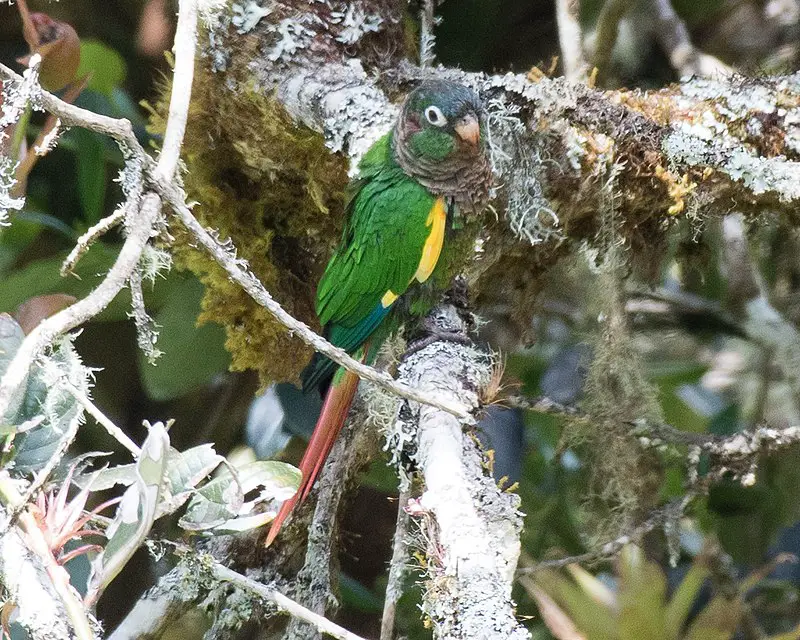
The Flame-winged Parakeet is a vibrant species of parrot found mainly in Colombia. It has striking brown and yellow feathers, with wings that are tipped by bright red flames – thus its name.
This beautiful bird inhabits forest edge and shrub at altitudes between 5,600 to 11,200 ft above sea level. Unfortunately it is threatened due to habitat loss caused by human activities such as deforestation.
Its scientific name ‘Pyrrhura calliptera’ was first described in 1854 by the French naturalist Charles Lucien Bonaparte. These birds form tight social groups which can include up to 12 individuals who feed on fruits and seeds while they chatter away.
Scientific classification:
| Kingdom | Animalia |
| Phylum | Chordata |
| Class | Aves |
| Order | Psittaciformes |
| Family | Psittacidae |
| Genus | Pyrrhura |
| Species | P. calliptera |
33. Turquoise Dacnis
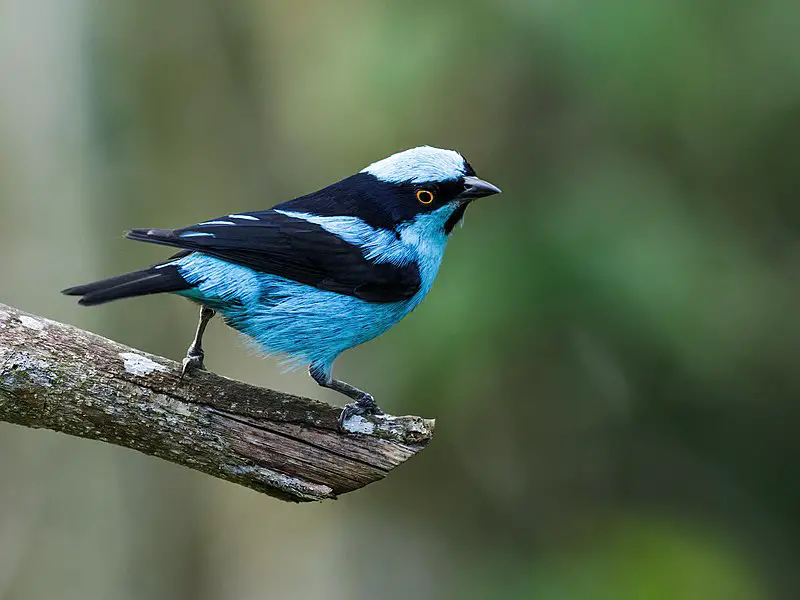
The turquoise dacnis is a stunningly vibrant bird native to Colombia. It belongs to the Thraupidae family and was formerly placed in its own genus, Pseudodacnis.
This species can be found inhabiting lowland forests, montane forests as well as plantations. Unfortunately, due to habitat loss it has been identified by BirdLife International as being threatened with extinction unless conservation efforts are made swiftly and effectively.
The turquoise plumage of this beautiful creature makes it hard not to appreciate – let’s hope we don’t lose such a special part of nature.
Scientific classification:
| Kingdom | Animalia |
| Phylum | Chordata |
| Class | Aves |
| Order | Passeriformes |
| Family | Thraupidae |
| Genus | Dacnis |
| Species | D. hartlaubi |
34. Chestnut-Bellied Flowerpiercer
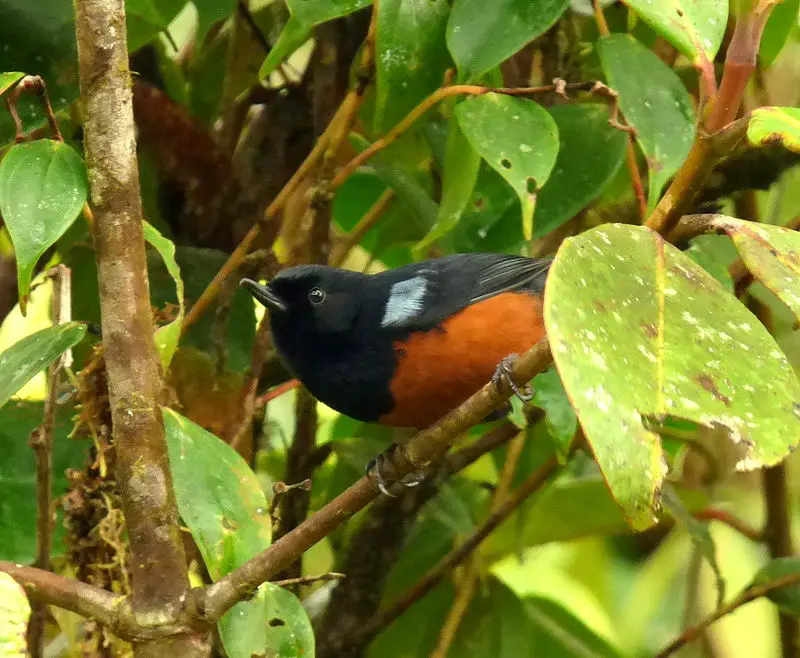
The Chestnut-bellied Flowerpiercer is a beautiful species of bird, found endemic to Colombia. It inhabits subtropical and tropical moist montane forests as well as high-altitude shrubland areas.
Although it’s an impressive sight with its brilliant plumage and strong beak, this species has unfortunately come under threat due to habitat loss. It was first described in 1912 by American ornithologist Frank M.
Chapman based on specimens collected from the Santa Marta mountains of Northeastern Colombia – making it one of the oldest known records for Colombian birds.
This gorgeous creature can easily be identified by its chestnut bellies, brown upperparts and white wing patches which make them stand out amongst other similarly coloured birds.
Unfortunately their numbers are decreasing rapidly but we hope that conservation efforts will help keep these amazing creatures around for generations to come.
Scientific classification:
| Kingdom | Animalia |
| Phylum | Chordata |
| Class | Aves |
| Order | Passeriformes |
| Family | Thraupidae |
| Genus | Diglossa |
| Species | D. gloriosissima |
35. Amazonian Motmot
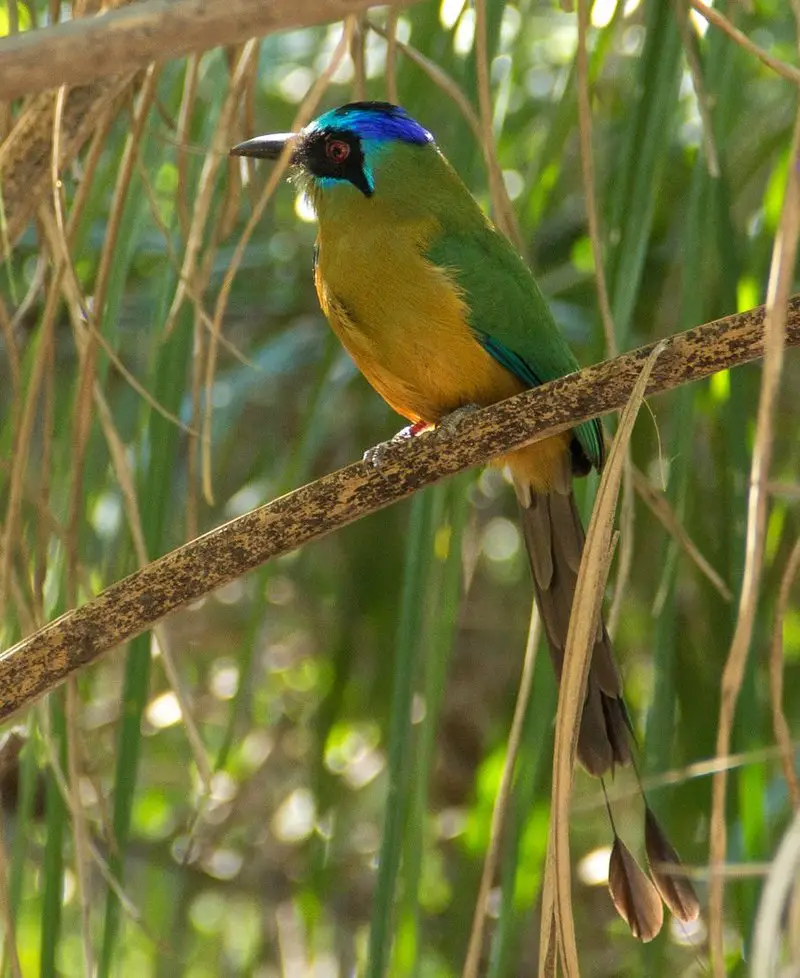
The Amazonian Motmot is a vibrant bird belonging to the family Momotidae. It can be found in lowland areas of South America, from Venezuela to Brazil and Argentina.
This colourful near-passerine has an impressive body length of up to 18 cm (7 inches) with striking green and blue plumage.
Its characteristic long tail tipped with two central feathers gives it a unique appearance that sets it apart from other birds in its region.
The diet consists mainly of insects, small reptiles or amphibians, as well as fruits and berries when available nearby.
As they are monogamous birds, males use their bright colours for display during courtship rituals which involve bowing displays and aerial acrobatics while chasing each other around tree branches.
Scientific classification:
| Kingdom | Animalia |
| Phylum | Chordata |
| Class | Aves |
| Order | Coraciiformes |
| Family | Momotidae |
| Genus | Momotus |
| Species | M. momota |
36. Flame-Rumped Tanager
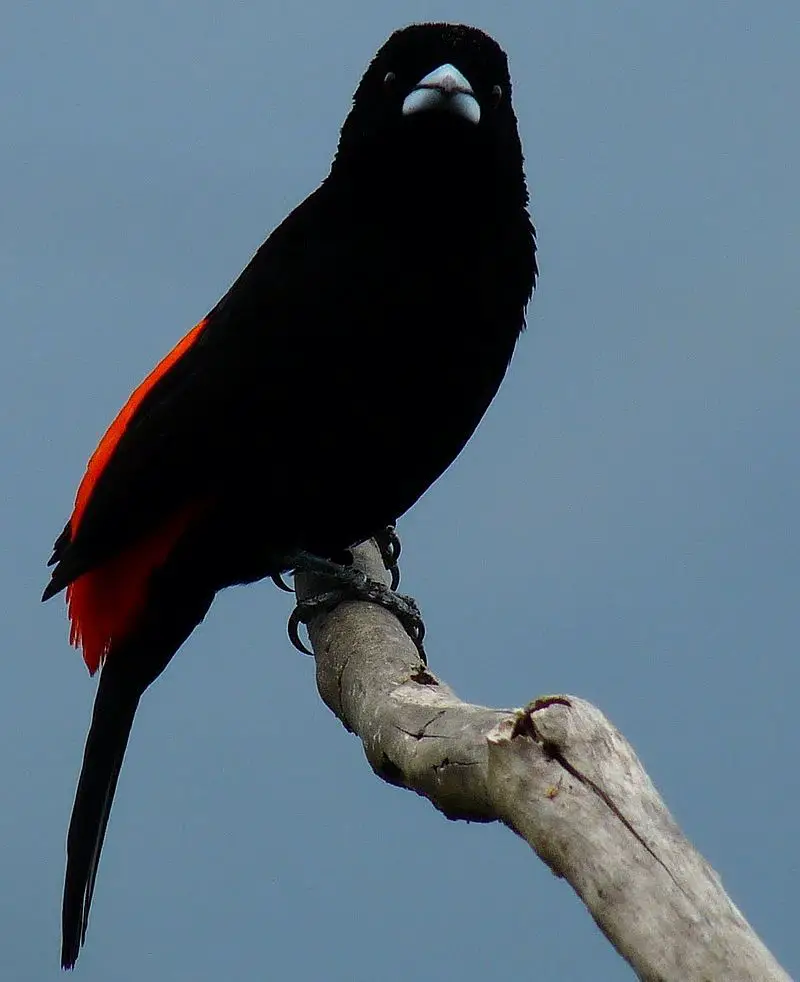
The Flame-rumped Tanager is a stunning bird with bright yellow body, black wings and tail, and a distinctive orange rump. It inhabits semi-open forests and woodlands of Panama, Colombia, Ecuador and Peru in the Tumbes-Chocó-Magdalena region.
This species has been known to hybridize with other tanagers such as the Lemon Rumped Tanager that some consider to be its own separate species but is generally accepted as part of this one.
The diet consists mainly of fruit supplemented by insects found in their habitat which helps them maintain their vibrant colouration due to high levels of carotenoids within these food sources.
They are monogamous birds who form strong pair bonds between mates for life although they may switch partners if unsuccessful at nesting or rearing young together.
These birds make an interesting addition to any backyard feeder or garden making it easy for us all to appreciate them.
Scientific classification:
| Kingdom | Animalia |
| Phylum | Chordata |
| Class | Aves |
| Order | Passeriformes |
| Family | Thraupidae |
| Genus | Ramphocelus |
| Species | R. flammigerus |
37. Chestnut-Winged Chachalaca
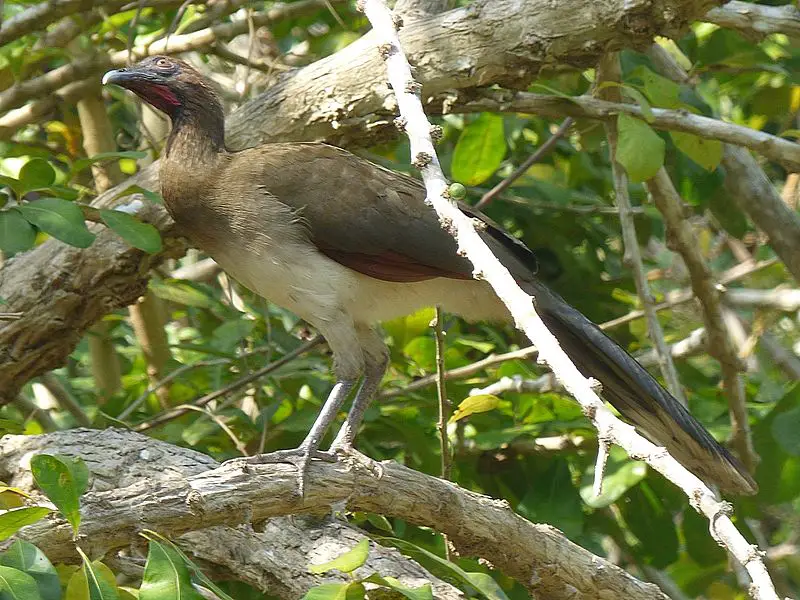
The Chestnut-winged Chachalaca is a species of bird that belongs to the family Cracidae. It is endemic to Colombia and has been classified as monotypic, meaning there are no subspecies known.
This chachalaca measures up to 60 cm in length and weighs around 600 grams for males. Its plumage includes chestnut brown wings with white spots on its back, grey head and neck, dark tail feathers and yellow below parts with orange stripes near their eyes.
They inhabit humid tropical forests from sea level up to 1800m above sea level where they feed on fruits such as figs or insects like grasshoppers among other things found in trees or shrubs during the day time when it’s active.
These birds form small flocks of 5–20 individuals which can sometimes be seen flying fast between tree branches making a very loud sound “cha cha la ca” after which they take their name from
Scientific classification:
| Kingdom | Animalia |
| Phylum | Chordata |
| Class | Aves |
| Order | Galliformes |
| Family | Cracidae |
| Genus | Ortalis |
| Species | O. garrula |
38. Indigo-Capped Hummingbird
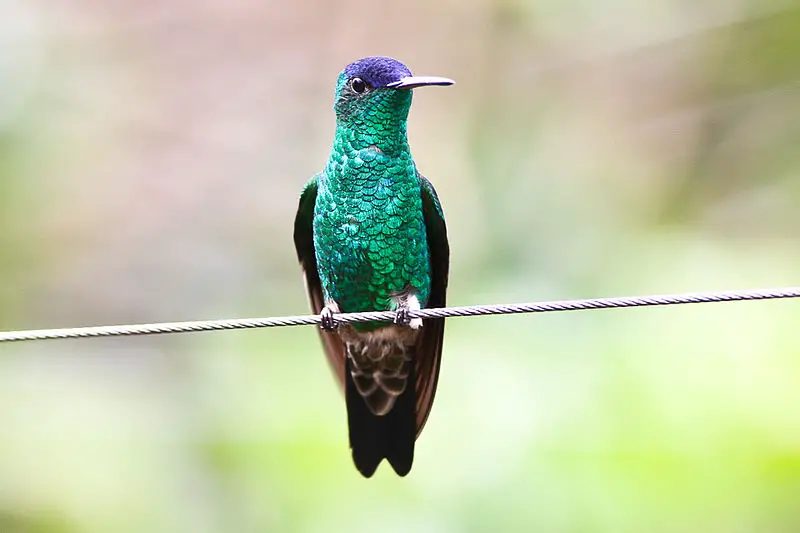
The Indigo-capped Hummingbird is a species of hummingbird native to Colombia. With its distinctive indigo crown, it stands out among the emeralds in its Trochilini tribe and subfamily Trochilinae.
Previously classified under Amazilia genus, scientists now recognize this bird as part of an entirely new monophyletic classification due to molecular phylogenetic studies conducted in 2014.
This tiny hummingbird lives mainly on nectar from flowers but also eats small insects for additional nutrition sources.
Its size ranges from 5 – 6 cm long with both males and females having similar plumage colouration; however male’s have longer tail feathers than that of the female counterpart’s shorter ones.
The Indio-Capped Hummingbird is not considered threatened at present but further conservation efforts are needed if we want these beautiful birds around us for many generations to come.
Scientific classification:
| Kingdom | Animalia |
| Phylum | Chordata |
| Class | Aves |
| Order | Apodiformes |
| Family | Trochilidae |
| Genus | Saucerottia |
| Species | S. cyanifrons |
39. King Vulture
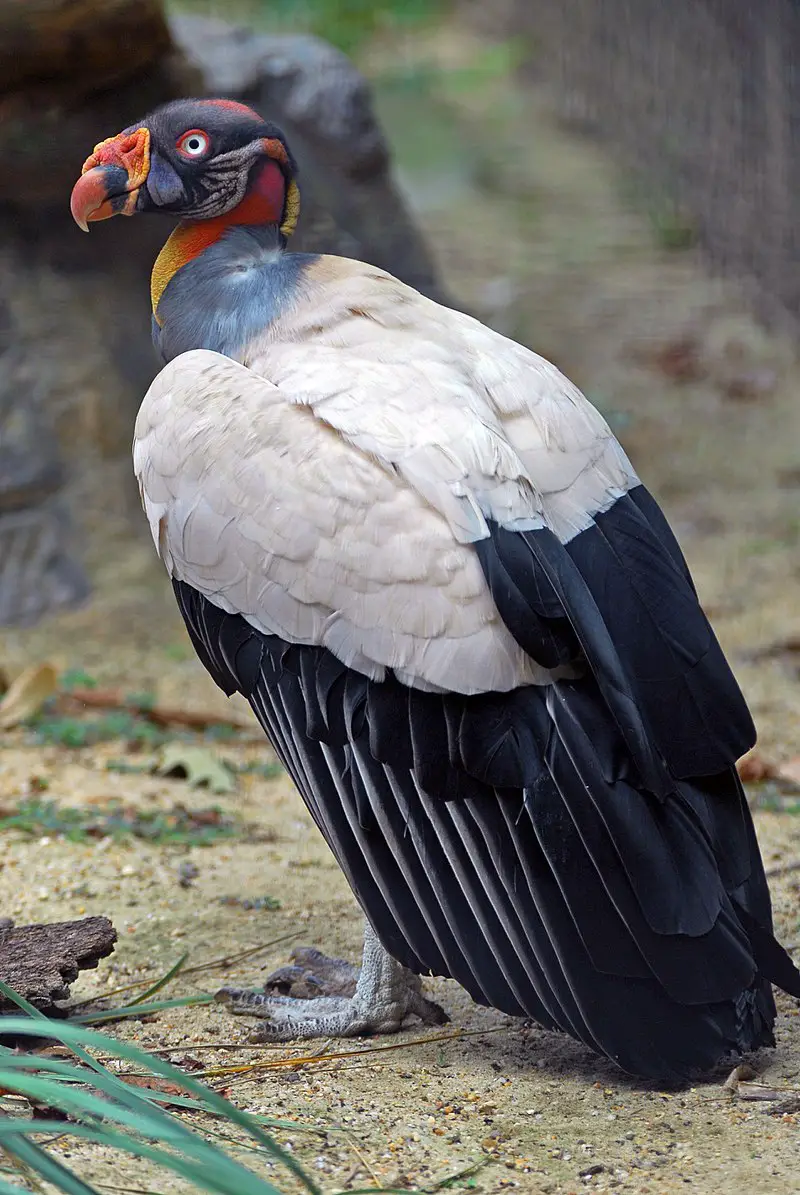
The King Vulture is a majestic bird found in Central and South America. It has striking white plumage with black accents, and its head is topped by a bright yellow crest.
With long wingspan of up to 4 feet, this vulture soars gracefully through the sky. Its large size allows it to dominate other scavenging birds at carcasses; although not as powerful as some raptors, the king vulture will protect what belongs to it fiercely.
The diet of these elegant creatures consists mainly of carrion such as dead mammals or fish that they spot from far away using their excellent vision.
They also occasionally eat eggs or nestlings if food is scarce during dry seasons.
This fascinating species plays an important role in keeping ecosystems healthy by removing dead animals from landscapes quickly before diseases spread further into populations
Scientific classification:
| Kingdom | Animalia |
| Phylum | Chordata |
| Class | Aves |
| Order | Accipitriformes |
| Family | Cathartidae |
| Genus | Sarcoramphus |
| Species | S. papa |
Also Featured In: Common Tropical Rainforest Birds, Scavengers Birds You Should Know
40. Tody Motmot
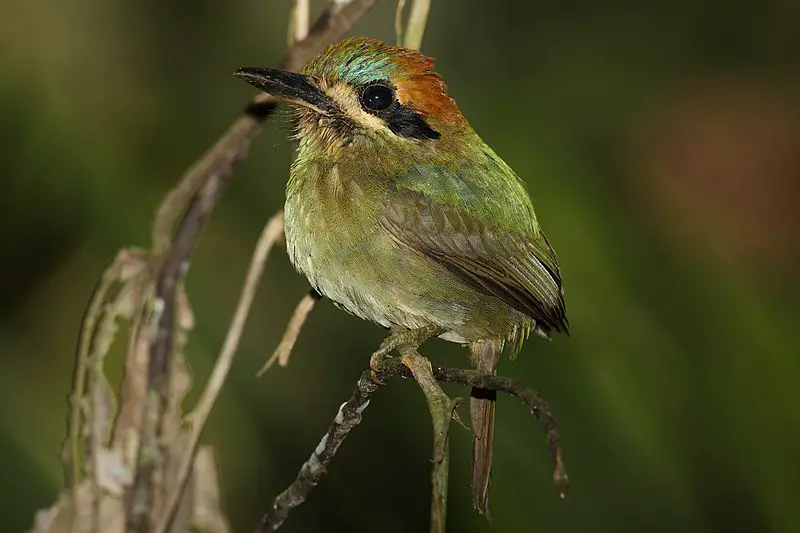
The Tody Motmot is a species of passerine bird belonging to the family Momotidae. It inhabits parts of Central America, ranging from Belize to Panama.
Distinguished by its bright colors and unique tail feathers, this bird stands out among its feathered friends in the tropical forest canopy.
Its most notable feature are two long central tail feathers with green iridescence which can be spread fan-like or kept close together for courtship displays or protection against predators.
The three subspecies differ slightly in size and plumage coloration patterns; however all share short rounded wings adapted for maneuvering through dense vegetation as they search for insects, small reptiles and amphibians on which they feed during their daily activities.
So if you ever find yourself exploring these lush rainforests take some time to observe one of nature’s true gems -the beautiful Tody Motmot.
Scientific classification:
| Kingdom | Animalia |
| Phylum | Chordata |
| Class | Aves |
| Order | Coraciiformes |
| Family | Momotidae |
| Genus | Hylomanes Lichtenstein, MHC, 1839 |
| Species | H. momotula |
41. Santa Marta Wren
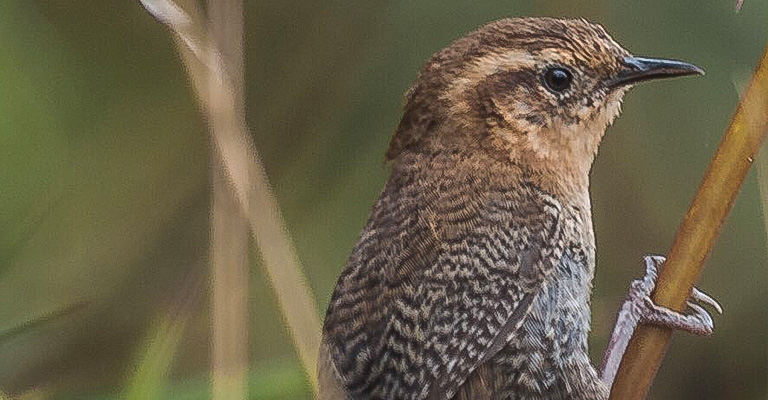
The Santa Marta wren is a species of bird that belongs to the family Troglodytidae. It can be found in Colombia and has been considered as subspecies of mountain wren by some experts.
This small-sized bird features brown upperparts, greyish underparts and white throat with slight rufous pattern on its face.
Its habitat includes dry forest, scrublands and agricultural lands located at altitudes between 1000–2700 m above sea level.
The diet of this species consists mainly insects such as beetles, ants or grasshoppers which it hunts from low shrubs or trees while moving around rapidly like most other members of their family do.
Unfortunately this species is threatened due to deforestation caused by human activities in addition to illegal trapping for pet trade industry hence making them vulnerable according to IUCN red list category criteria evaluation results
Scientific classification:
| Kingdom | Animalia |
| Phylum | Chordata |
| Class | Aves |
| Order | Passeriformes |
| Family | Troglodytidae |
| Genus | Troglodytes |
| Species | T. monticola |
42. Santa Marta Woodstar
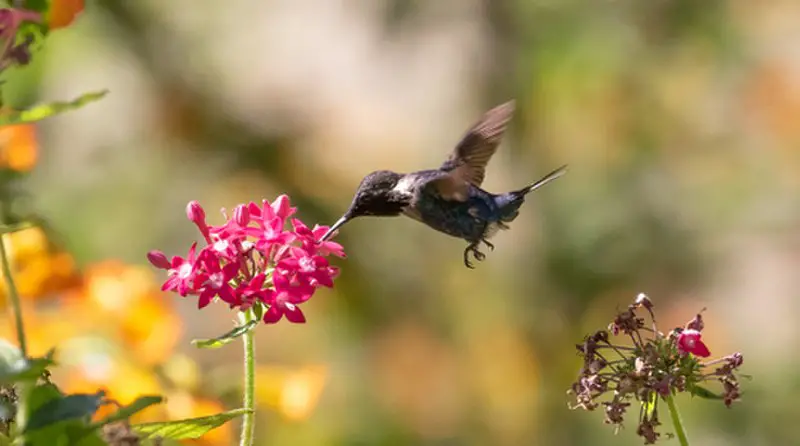
The Santa Marta woodstar is a small hummingbird, endemic to Colombia and belonging to the Mellisugini tribe of Trochilinae subfamily. It was formerly placed in genus Acestrura but has now been moved into its own species within Chaetocercus.
This bird features unique markings including a white crescent-shaped patch on their throats, resembling an amulet or gorget – hence it’s given name.
The coloration also includes purple-bronze feathers with white tips which are tipped by black edging around the wings and tail feathers.
These birds feed mainly on nectar from flowers as well as catching insects midair for extra energy sources when needed. They can be found flitting amongst bushes at middle elevations in search of food supplies throughout Colombia making them quite common visitors there.
Scientific classification:
| Kingdom | Animalia |
| Phylum | Chordata |
| Class | Aves |
| Order | Apodiformes |
| Family | Trochilidae |
| Genus | Chaetocercus |
| Species | C. astreans |
43. Apolinar’s Wren
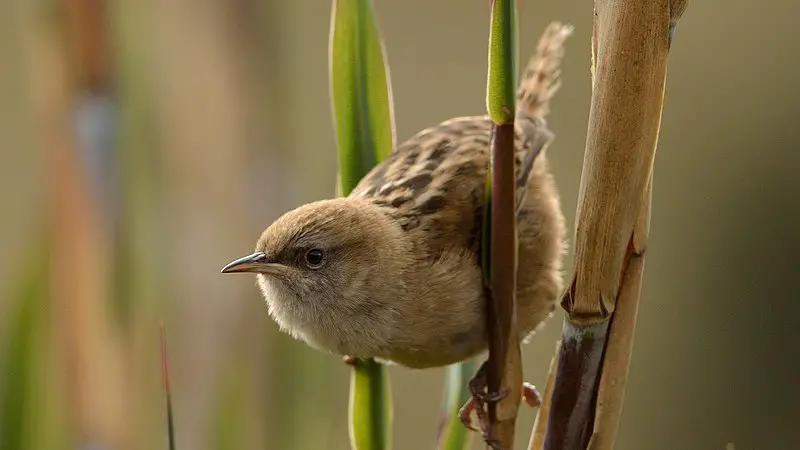
Apolinar’s wren is a small passerine bird belonging to the family Troglodytidae. Endemic to Colombia, it has two subspecies: Cistothorus apolinari apolinari and C.a hernandezi.
The latter was recently described in 2002 and may even be considered its own species due to certain morphological differences from the former one.
Additionally, Apolinar’s wren shares many similarities with grass wren (Cistothorus platensis) and Mérida Wren (Cisthorus meridae), forming an superspecies complex between them all.
It is a delightful little creature that could easily brighten up your garden as you watch it flitting around happily amongst the plants.
Scientific classification:
| Kingdom | Animalia |
| Phylum | Chordata |
| Class | Aves |
| Order | Passeriformes |
| Family | Troglodytidae |
| Genus | Cistothorus |
| Species | C. apolinari |
44. American Flamingo
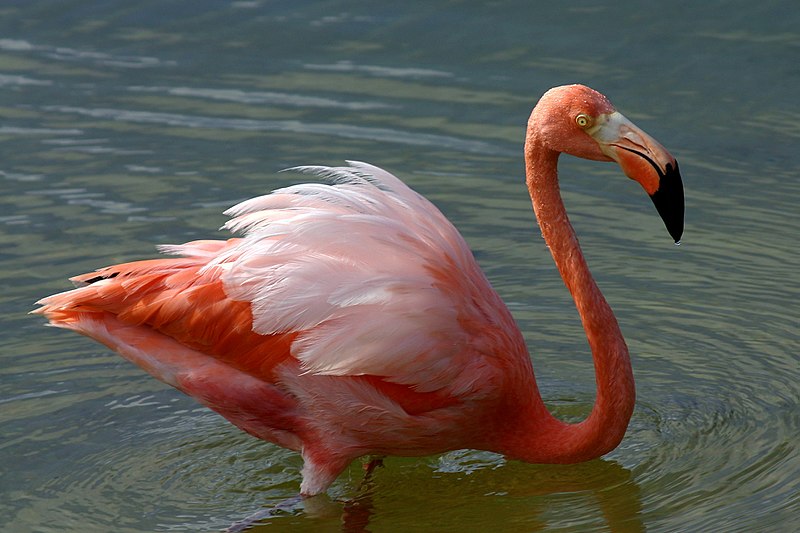
The American flamingo is a large species of bird found in the Neotropics. It has bright pink feathers and long legs, making it easily distinguishable from other species of flamingos.
The diet consists mostly of shrimp and small fish but they are also known to eat algae, aquatic insects, mollusks, crustaceans and seeds.
They live around coastal lagoons or salt ponds in colonies with thousands of birds nesting together on mud flats.
Flamingos build nests out of sticks that sit atop their feet as they wade through shallow waters looking for food during low tide periods when these areas become more accessible for feeding purposes.
These birds have an interesting courtship ritual involving neck stretching which looks like a dance to attract mates before breeding season begins in May-June each year leading to chicks hatching during July-August time period
Scientific classification:
| Kingdom | Animalia |
| Phylum | Chordata |
| Class | Aves |
| Order | Phoenicopteriformes |
| Family | Phoenicopteridae |
| Genus | Phoenicopterus |
| Species | P. ruber |
Also Featured In: Galapagos Birds You Should Know, Birds that Make Mud Nests
45. Harpy Eagle
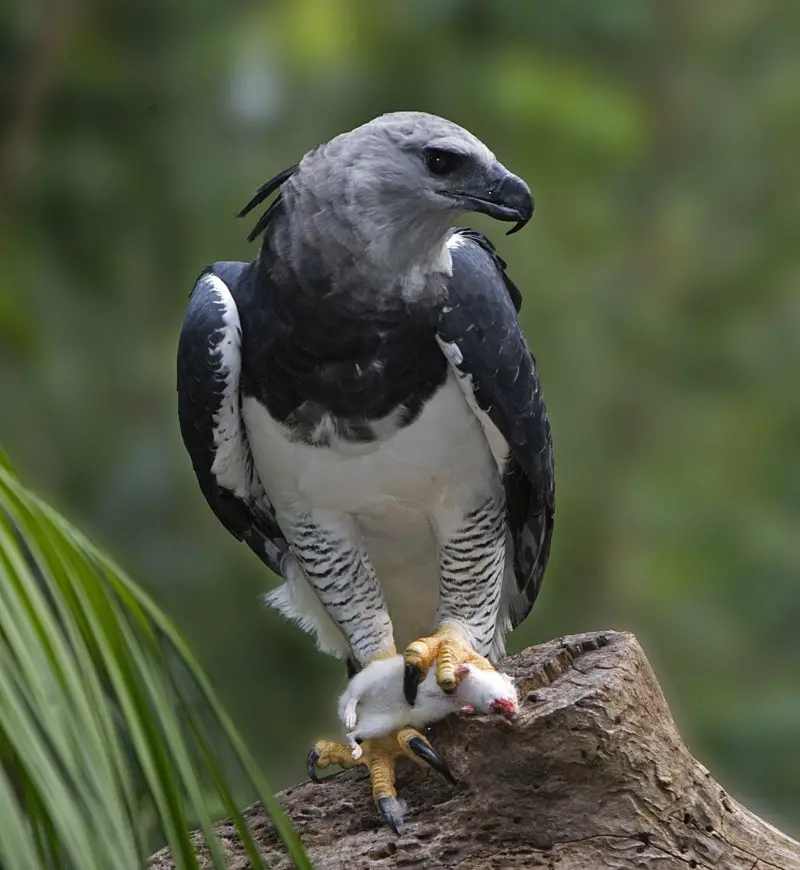
The Harpy Eagle is a magnificent bird of prey found in the tropical forests of Central and South America. It is the largest eagle on Earth, possessing an impressive wingspan that can reach up to 7 feet across.
Its powerful talons are its most distinguishing feature, being able to grasp even large animals such as monkeys or sloths with ease.
The majestic raptor has slate-gray feathers on its back and head which contrast against white undersides and yellow legs.
These birds live alone for much of their life but will come together during breeding season when they construct elaborate nests high off the ground in tall trees.
People have long been fascinated by this species’ impressive size and strength—it truly deserves its nickname as “the lord of skies”.
Scientific classification:
| Kingdom | Animalia |
| Phylum | Chordata |
| Class | Aves |
| Order | Accipitriformes |
| Family | Accipitridae |
| Subfamily | Harpiinae |
| Genus | Harpia Vieillot, 1816 |
| Species | H. harpyja |
Also Featured In: Common Carnivore Birds,
46. Pharomachrus
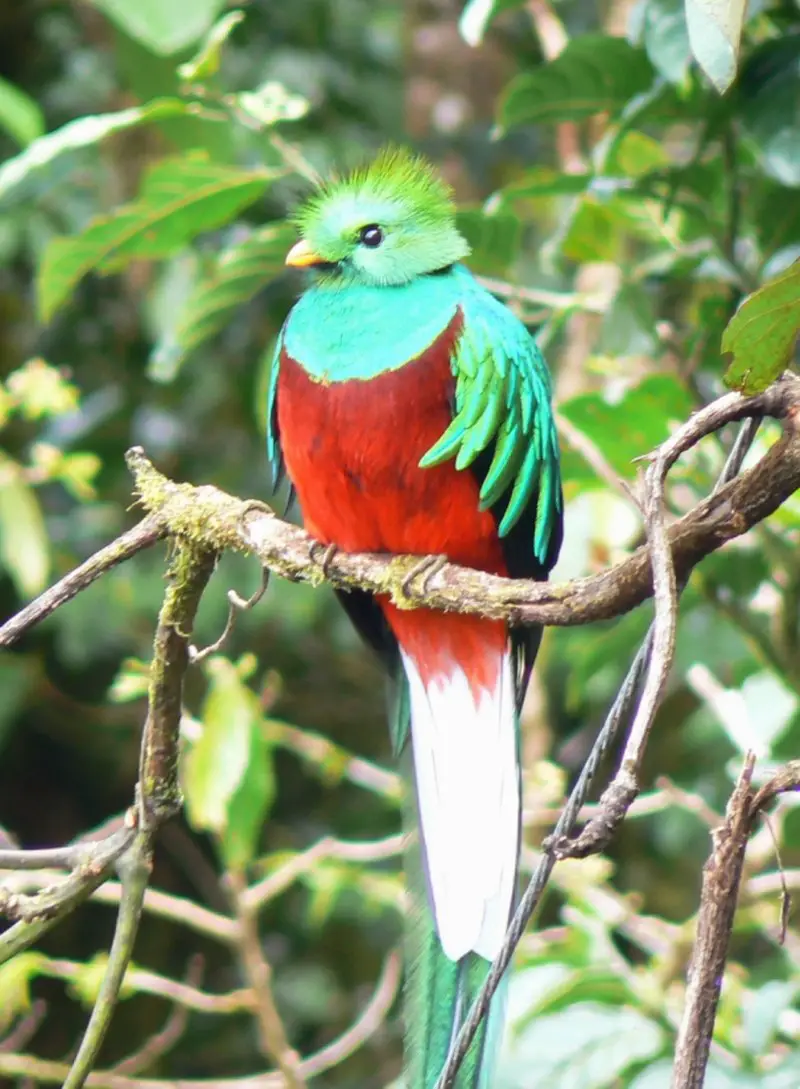
Pharomachrus is a genus of birds belonging to the Trogonidae family. These strikingly colorful creatures are commonly known as quetzals, and comprise of five species in this single genus.
Its name originates from Ancient Greek words ‘pharos’ meaning mantle, and ‘makros’ which means long – referring to its wing coverts that appear like mantles when fully spread out.
The Eared Quetzal is the only surviving member of the related but distinct Genus Euptilotis, making it one among these six beautiful avian jewels found mostly in Central America and parts of Southwestern North America.
Scientific classification:
| Kingdom | Animalia |
| Phylum | Chordata |
| Class | Aves |
| Order | Trogoniformes |
| Family | Trogonidae |
| Genus | Pharomachrus de la Llave, 1832 |
47. Santa Marta Brushfinch
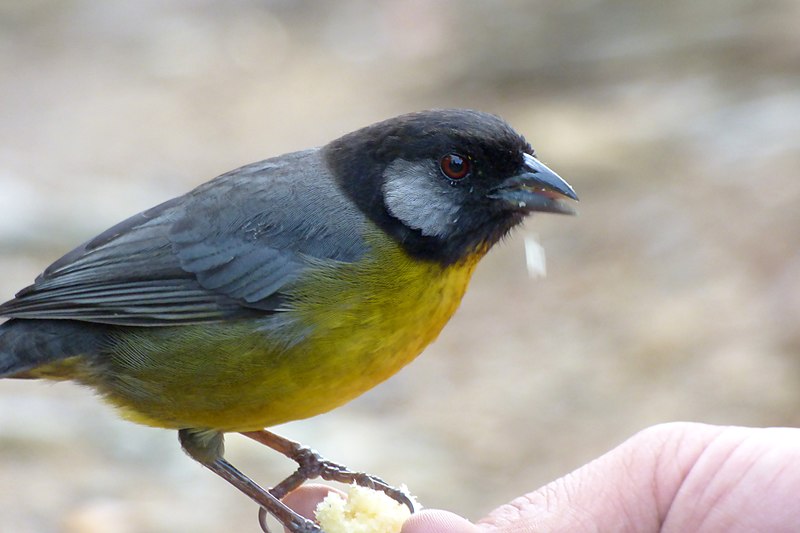
The Santa Marta brushfinch is a small bird native to the Sierra Nevada de Santa Marta in Colombia. It belongs to the family Passerellidae and has distinct dark gray-black head feathers which give it its unique name.
This species prefers subtropical or tropical moist montane forests as well as heavily degraded former forests, making it an adaptable species that can survive even in disturbed areas of its mountain habitat.
The conservation status of this rare bird is listed “vulnerable” due to loss of suitable habitat caused by logging and other human activity; however, populations are still stable for now with some local protection efforts underway in order to ensure their continued survival into the future.
Scientific classification:
| Kingdom | Animalia |
| Phylum | Chordata |
| Class | Aves |
| Order | Passeriformes |
| Family | Passerellidae |
| Genus | Atlapetes |
| Species | A. melanocephalus |
48. Orange-Breasted Fruiteater
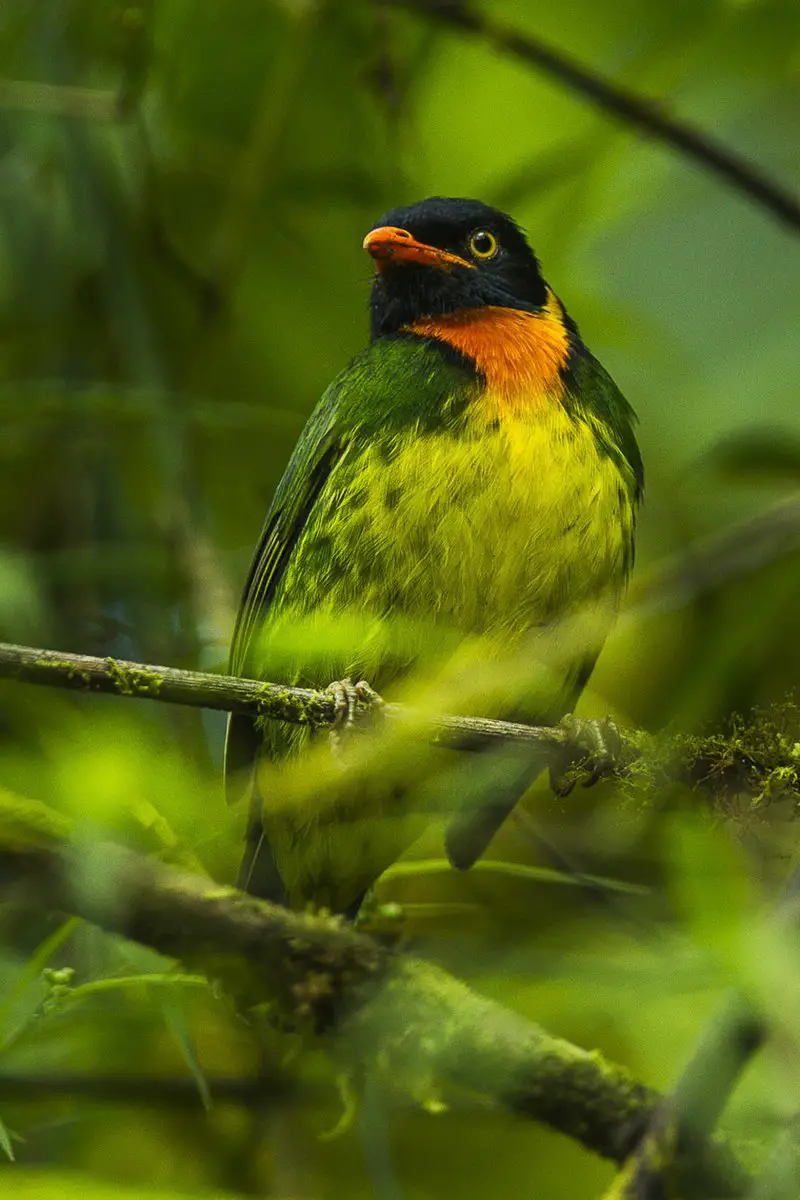
The Orange-breasted fruiteater is a brightly coloured bird native to Colombia and Ecuador. It measures 18 cm long, with males having glossy black heads and bibs contrasted against an orange throat and yellow belly.
Females lack the dark head, but have green upper parts with contrasting green and white bellies. They inhabit subtropical or tropical moist montane forests where they feed on fruit from trees such as figs, guavas, bananas or mangoes.
In addition to their diet of fruits they also eat insects like beetles for protein which provides energy for flying between perches in search of food sources within dense canopy cover.
Scientific classification:
| Kingdom | Animalia |
| Phylum | Chordata |
| Class | Aves |
| Order | Passeriformes |
| Family | Cotingidae |
| Genus | Pipreola |
| Species | P. jucunda |
49. Yellow-Headed Brushfinch
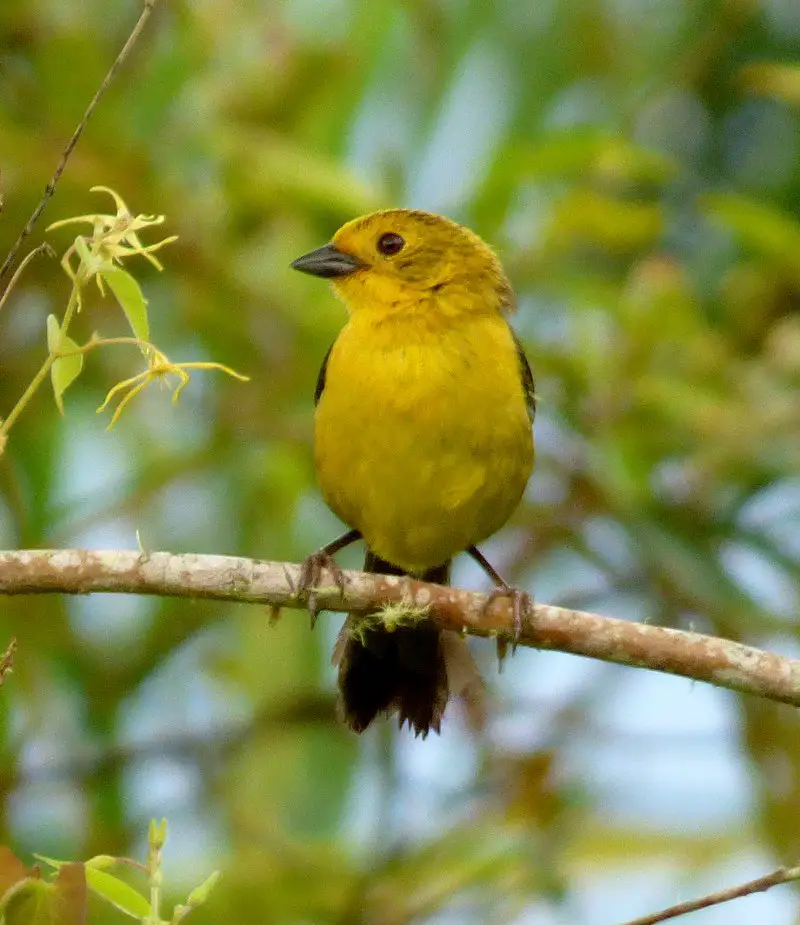
The Yellow-headed Brushfinch is an attractive small bird that can be found in Colombia. It has a yellow to dark olive head, with a throat and chin of the same color as well as a malar streak running from behind its eyes down to its neck.
The breast and sides are grayish-brown while the back is streaked with black and white barring. Its wings are mostly brown but have some pale buff spots on them too.
This species feeds mainly on insects, seeds, fruits, buds or flowers depending upon what’s seasonally available for it to feed upon.
Unfortunately due to habitat destruction this beautiful near threatened species may face great risk in future if their natural habitats aren’t preserved soon enough.
Scientific classification:
| Kingdom | Animalia |
| Phylum | Chordata |
| Class | Aves |
| Order | Passeriformes |
| Family | Passerellidae |
| Genus | Atlapetes |
| Species | A. flaviceps |
50. Colombian Chachalaca
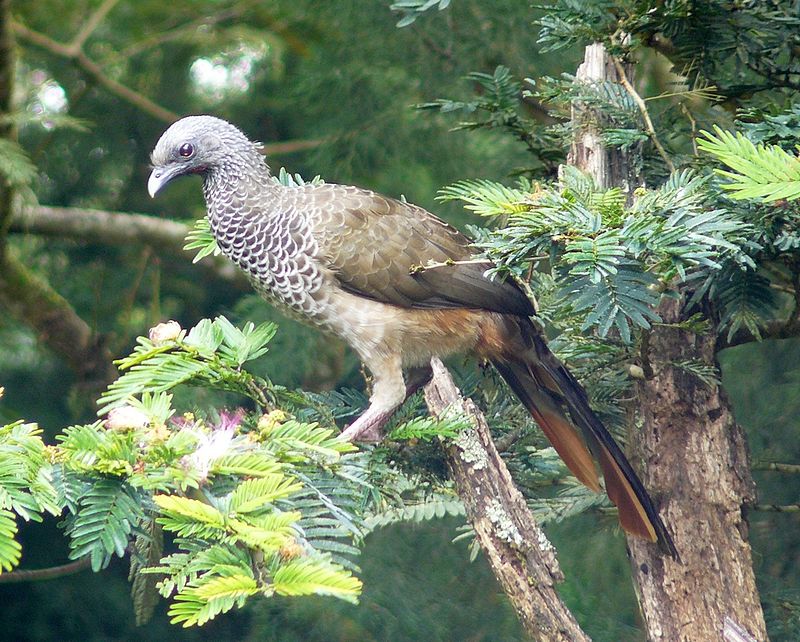
The Colombian Chachalaca is a species of bird in the Cracidae family endemic to Colombia. This frugivorous creature lives an arboreal lifestyle, often seen foraging fruits from trees and shrubs in inter-Andean valleys.
It plays a significant role in maintaining tropical forests as it disperses large seeds through defecation. This magnificent bird was first formally described by American zoologist Edward William Nelson back in 1906 and has since been identified as one of the most common birds found across its range.
Its vibrant plumage consisting of olive green wings, white underparts with rusty spots, chestnut neck patch and long tail feathers makes it hard to miss.
Scientific classification:
| Kingdom | Animalia |
| Phylum | Chordata |
| Class | Aves |
| Order | Galliformes |
| Family | Cracidae |
| Genus | Ortalis |
| Species | O. columbiana |
51. Greyish Piculet
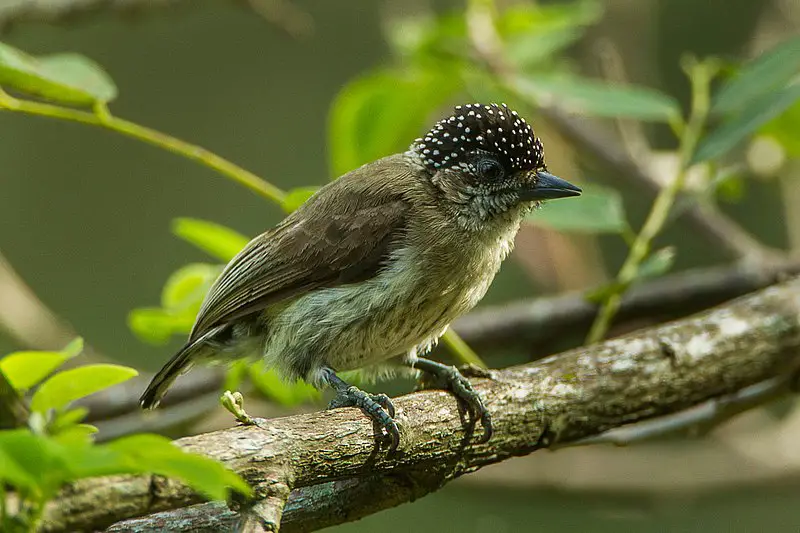
The Greyish Piculet is a small woodpecker found in Colombia. It belongs to the family of Picidae and is part of a superspecies with the Olivaceous piculet, which might even be conspecific or same species.
There are two subspecies: P. g. antioquensis in the north & P.g granadensis in south Colombia’s range; both have black crowns, olive-gray backs and wings, white belly spots and buffy throats/breasts with dark streaks on them forming an eye mask like pattern around their eyes.
They inhabit dry forests along streams as well as humid lowlands where they feed mainly on insects such as ants & beetles that it finds by pecking at tree bark trunks or branches while clinging onto them using its sharp claws for support.
Scientific classification:
| Kingdom | Animalia |
| Phylum | Chordata |
| Class | Aves |
| Order | Piciformes |
| Family | Picidae |
| Genus | Picumnus |
| Species | P. granadensis’ |